#thermal imaging camera system
Explore tagged Tumblr posts
Text
Thermal Imaging Market to be Worth $7.8 Billion by 2032
Meticulous Research®—a leading global market research company, published a research report titled, ‘Thermal Imaging Market by Type (Handheld Cameras, Fixed Cameras, Scopes, Modules), Technology (Cooled, Uncooled), Wavelength (SWIR, MWIR, LWIR), Application (Security & Surveillance) - Global Forecast to 2032’
According to the latest publication from Meticulous Research®, the thermal imaging market is expected to reach $7.8 billion by 2032, at a CAGR of 7.2% from 2025 to 2032. This market’s growth is attributed to several factors, such as the growing need for surveillance & security solutions and the increasing utilization of thermal imaging in manufacturing and industrial settings. Additionally, the surge in demand for thermal imaging in healthcare, growing military & defense expenditure in advanced surveillance technologies, and rising unmanned aerial vehicles (UAVs) are expected to create market growth opportunities. However, the availability of alternative imaging technologies, such as visible light cameras & radar systems, may restrain the growth of this market.
On the other hand, the high cost of thermal imaging devices is a major challenge for the players operating in this market.
The global thermal imaging market is segmented by type, technology, wavelength, and application. This study also evaluates end-user industry competitors and analyzes the market at the region/country level.
Download Sample Report Here @ https://www.meticulousresearch.com/download-sample-report/cp_id=5978
Based on type, the thermal imaging market is broadly segmented into handheld/portable cameras, fixed/mounted cameras, scopes & eyewear, and modules. In 2025, the portable or handheld cameras segment is expected to account for the largest share, over 55.0%. This segment's large market share is attributed to its features, such as ease of use and portability, and the growing use of portable or handheld cameras for field inspection & maintenance and emergency and rescue operations.
However, the fixed/mounted cameras segment is expected to register the highest CAGR during the forecast period. This segment’s growth is driven by its ability to provide continuous, high-precision, real-time monitoring of critical infrastructure without the need for manual intervention, to withstand harsh environmental conditions, and its increasing demand for fixed thermal cameras for integrating with automated security and monitoring systems.
Based on technology, the thermal imaging market is segmented into cooled thermal imaging and uncooled thermal imaging. In 2025, the cooled thermal imaging segment is expected to account for a larger share of over 64.0% of the thermal imaging market. This segment’s large market share is due to its sensitivity, high accuracy, long-range detection, and image resolution, which allows for the detection of minute temperature differences and the capture of detailed thermal images and increasing use of cooled thermal imaging for extreme environmental conditions, such as high-temperature industrial environments or cold regions.
However, the uncooled thermal imaging segment is expected to register the highest CAGR during the forecast period. This segment’s growth is driven by its features, including cost-effectiveness, ease of maintenance, reduced operational costs, and growing demand for uncooled thermal imaging products in applications such as building diagnostics, wildlife monitoring, emergency response, law enforcement, and temporary monitoring needs in various scenarios.
Based on wavelength, the thermal imaging market is segmented into shortwave infrared (SWIR), mid-wave infrared (MWIR), and longwave infrared (LWIR). In 2025, the LWIR segment is expected to account for the largest share of over 49.0% of the thermal imaging market. The growing use of LWIR cameras in environmental monitoring, advanced driver assistance systems (ADAS), security and surveillance, and the need to detect thermal radiation emitted by objects across various industries are the main causes of this segment's large market share. Other factors include the segment's ability to provide non-contact temperature measurement for monitoring high-temperature processes and equipment, and its cost-effectiveness in comparison to MWIR and SWIR systems.
However, the SWIR segment is expected to register the highest CAGR during the forecast period. This growth is driven by its superior image contrast and detail, enhanced capability to ensure clear visibility in challenging environmental conditions, including smoke, fog, and haze, and growing demand for SWIR technology in medical diagnostics for non-invasive imaging.
Based on application, the thermal imaging market is segmented into aerospace & defense, security & surveillance, building & construction, personal vision systems, healthcare & medical diagnostics, energy & utilities, agriculture, research & development, search & rescue operations, marine systems, and other applications. In 2025, the security & surveillance segment is expected to account for the largest share of over 41.0% of the thermal imaging market. The growing need for improved surveillance capabilities, such as visibility in low light and obscured conditions, the growing use of thermal imaging to improve perimeter security for securing sensitive facilities and high-profile events, and the growing integration of thermal cameras into smart security systems to the overall effectiveness of security measures are all factors contributing to this segment's large market share.
However, the healthcare & medical diagnostics segment is expected to register the highest CAGR during the forecast period. This growth is being driven by an increase in demand for thermal imaging technology owing to its non-invasive nature for early disease detection by identifying abnormal heat patterns associated with conditions such as breast cancer, vascular disorders, and inflammation, and an increase in the use of thermal imaging for fever screening in public areas and in veterinary medicine to diagnose and monitor health conditions in animals.
Based on geography, the thermal imaging market is segmented into North America, Europe, Asia-Pacific, Latin America, and the Middle East & Africa. In 2025, North America is expected to account for the largest share of over 36.0% of the thermal imaging market.
North America's significant market share can be attributed to several key factors, including rising concerns over terrorism, crime, and public safety, increasing deployment of thermal imaging in large-scale surveillance applications such as city-wide monitoring or border control, increasing technological advancements in thermal imaging, high investments in advanced technologies for military and defense applications, and growing focus on advancing medical tools for non-invasive diagnostics and early disease detection.
Moreover, Asia-Pacific is expected to register the highest CAGR of over 8.5% during the forecast period.
Key Players:
The key players operating in the thermal imaging market are Teledyne FLIR LLC (U.S.) (a subsidiary of Teledyne Technologies Incorporated (U.S.)), Fluke Corporation (U.S.), L3Harris Technologies, Inc. (U.S.), Leonardo S.p.A. (Italy), Axis Communications AB (Sweden), BAE Systems plc (U.K.), RTX Corporation (U.S.), Lockheed Martin Corporation (U.S.), Testo SE & Co. KGaA (Germany), Thales Group (France), Seek Thermal, Inc. (U.S.), Exosens (France), Honeywell International Inc. (U.S.), Trijicon, Inc. (U.S.), Cantronic Systems, Inc. (U.S.), Safran Group (France), Zhejiang Dali Technology Co., Ltd. (China), HT Italia S.r.l. (Italy), Thermoteknix Systems Ltd. (U.K.), and Bullard (U.S.).
Complete Report Here : https://www.meticulousresearch.com/product/thermal-imaging-market-5978
Key questions answered in the report-
Which are the high-growth market segments based on type, technology, wavelength, application, and geography?
What was the historical market for the thermal imaging market?
What are the market forecasts and estimates for the period 2025–2032?
What are the major drivers, restraints, opportunities, and challenges in the thermal imaging market?
Who are the major players, and what shares do they hold in the thermal imaging market?
What is the competitive landscape in the thermal imaging market?
What are the recent developments in the thermal imaging market?
What do the major players adopt the different strategies in the thermal imaging market?
What are the key geographic trends, and which are the high-growth countries?
Who are the local emerging players in the global thermal imaging market, and how do they compete with the other players?
Contact Us: Meticulous Research® Email- [email protected] Contact Sales- +1-646-781-8004 Connect with us on LinkedIn- https://www.linkedin.com/company/meticulous-research
#Thermal Imaging Market#Thermal Image#Night Vision#Thermogram#Security & Surveillance#Monitoring & Inspection#Fire Fighting#Personal Vision Systems#Vehicle Targeting#Counter-Unmanned Aircraft Systems (C-UAS)#Maritime & Coastal Surveillance#Search & Rescue Operation#Space Exploration Thermal Mapping#Handheld/Portable Cameras#Fixed/Mounted Cameras#Thermal Scopes#Military Targeting Systems#Perimeter Surveillance
0 notes
Text

Innovating the Thermal Management System Market
Dive into our comprehensive thermal management system market offerings, meticulously designed to optimize performance across diverse applications. Explore our range of cutting-edge cold plate technology, crafted with precision engineering to deliver unparalleled efficiency in dissipating heat. From electronics to automotive, our solutions are tailored to meet the exacting demands of modern industries. Stay ahead with our innovative thermal management solutions, ensuring your systems operate at peak performance levels, regardless of the operating environment. Trust us to elevate your thermal management strategy to new heights.
#thermal management system market#cold plate technology#Medical#health#Automotive#cooling aerospace#aerospace#military aviation#aircraft#industrial equipment#renewable energy#green energy#heavy equipment#power generation#electronics#photonics#transportation#thermal imaging camera
0 notes
Text
25 Years of Exploring the Universe with NASA's Chandra Xray Observatory

Illustration of the Chandra telescope in orbit around Earth. Credit: NASA/CXC & J. Vaughan
On July 23, 1999, the space shuttle Columbia launched into orbit carrying NASA’s Chandra X-ray Observatory. August 26 marked 25 years since Chandra released its first images.
These were the first of more than 25,000 observations Chandra has taken. This year, as NASA celebrates the 25th anniversary of this telescope and the incredible data it has provided, we’re taking a peek at some of its most memorable moments.
About the Spacecraft
The Chandra telescope system uses four specialized mirrors to observe X-ray emissions across the universe. X-rays that strike a “regular” mirror head on will be absorbed, so Chandra’s mirrors are shaped like barrels and precisely constructed. The rest of the spacecraft system provides the support structure and environment necessary for the telescope and the science instruments to work as an observatory. To provide motion to the observatory, Chandra has two different sets of thrusters. To control the temperatures of critical components, Chandra's thermal control system consists of a cooling radiator, insulators, heaters, and thermostats. Chandra's electrical power comes from its solar arrays.
Learn more about the spacecraft's components that were developed and tested at NASA’s Marshall Space Flight Center in Huntsville, Alabama. Fun fact: If the state of Colorado were as smooth as the surface of the Chandra X-ray Observatory mirrors, Pike's Peak would be less than an inch tall.
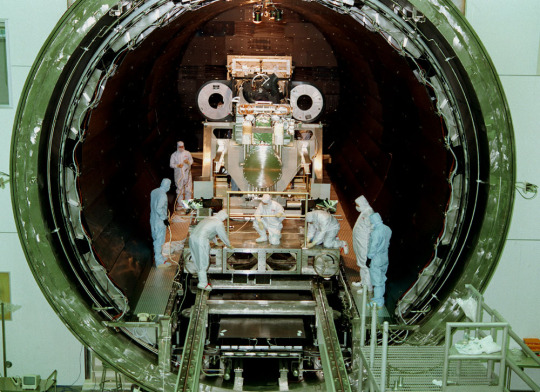
Engineers in the X-ray Calibration Facility at NASA’s Marshall Space Flight Center in Huntsville, Alabama, integrating the Chandra X-ray Observatory’s High-Resolution Camera with the mirror assembly, in this photo taken March 16, 1997. Credit: NASA
Launch
When space shuttle Columbia launched on July 23, 1999, Chandra was the heaviest and largest payload ever launched by the shuttle. Under the command of Col. Eileen Collins, Columbia lifted off the launch pad at NASA’s Kennedy Space Center in Florida. Chandra was deployed on the mission’s first day.

Reflected in the waters, space shuttle Columbia rockets into the night sky from Launch Pad 39-B on mission STS-93 from Kennedy Space Center. Credit: NASA
First Light Images
Just 34 days after launch, extraordinary first images from our Chandra X-ray Observatory were released. The image of supernova remnant Cassiopeia A traces the aftermath of a gigantic stellar explosion in such captivating detail that scientists can see evidence of what is likely the neutron star.
“We see the collision of the debris from the exploded star with the matter around it, we see shock waves rushing into interstellar space at millions of miles per hour,” said Harvey Tananbaum, founding Director of the Chandra X-ray Center at the Smithsonian Astrophysical Observatory.

Cassiopeia A is the remnant of a star that exploded about 300 years ago. The X-ray image shows an expanding shell of hot gas produced by the explosion colored in bright orange and yellows. Credit: NASA/CXC/SAO
A New Look at the Universe
NASA released 25 never-before-seen views to celebrate the telescopes 25th anniversary. This collection contains different types of objects in space and includes a new look at Cassiopeia A. Here the supernova remnant is seen with a quarter-century worth of Chandra observations (blue) plus recent views from NASA’s James Webb Space Telescope (grey and gold).

This image features deep data of the Cassiopeia A supernova, an expanding ball of matter and energy ejected from an exploding star in blues, greys and golds. The Cassiopeia A supernova remnant has been observed for over 2 million seconds since the start of Chandra’s mission in 1999 and has also recently been viewed by the James Webb Space Telescope. Credit: NASA/CXC/SAO
Can You Hear Me Now?
In 2020, experts at the Chandra X-ray Center/Smithsonian Astrophysical Observatory (SAO) and SYSTEM Sounds began the first ongoing, sustained effort at NASA to “sonify” (turn into sound) astronomical data. Data from NASA observatories such as Chandra, the Hubble Space Telescope, and the James Webb Space Telescope, has been translated into frequencies that can be heard by the human ear.
SAO Research shows that sonifications help many types of learners – especially those who are low-vision or blind -- engage with and enjoy astronomical data more.
Click to watch the “Listen to the Universe” documentary on NASA+ that explores our sonification work: Listen to the Universe | NASA+

An image of the striking croissant-shaped planetary nebula called the Cat’s Eye, with data from the Chandra X-ray Observatory and Hubble Space Telescope. NASA’s Data sonification from Chandra, Hubble and/or Webb telecopes allows us to hear data of cosmic objects. Credit: NASA/CXO/SAO
Celebrate With Us!
Dedicated teams of engineers, designers, test technicians, and analysts at Marshall Space Flight Center in Huntsville, Alabama, are celebrating with partners at the Chandra X-ray Center and elsewhere outside and across the agency for the 25th anniversary of the Chandra X-ray Observatory. Their hard work keeps the spacecraft flying, enabling Chandra’s ongoing studies of black holes, supernovae, dark matter, and more.
Chandra will continue its mission to deepen our understanding of the origin and evolution of the cosmos, helping all of us explore the Universe.

The Chandra Xray Observatory, the longest cargo ever carried to space aboard the space shuttle, is shown in Columbia’s payload bay. This photo of the payload bay with its doors open was taken just before Chandra was tilted upward for release and deployed on July 23, 1999. Credit: NASA
Make sure to follow us on Tumblr for your regular dose of space: http://nasa.tumblr.com
2K notes
·
View notes
Text
Relentless direct action has secured another victory in the fight against Israel’s arms trade, as Elbit Systems are forced to sell their ‘Elite KL’ factory in Tamworth.
The company had previously manufactured cooling and power management systems for military vehicles, but was sold on after stating that it faced falling profits and increased security costs resulting from Palestine Action’s efforts.
After the sale was completed last month, Elite KL’s new owners, listed as Griffin Newco Ltd, confirmed in an email to Palestine Action that they will have nothing to do with the previous owners, Elbit, and have discontinued any arms manufacturing:
“Following the recent acquisition of Elite KL Limited by a UK investment syndicate, the newly appointed board has unanimously agreed to withdraw from all future defence contracts and terminate its association with its former parent company”.
This victory is a direct result of sustained direct action which has sought, throughout Palestine Action’s existence, to make it impossible for Elbit to afford to operate in Britain. Before they sold the enterprise to a private equity syndicate, Elbit had reported that Elite KL operating profits had been slashed by over three-quarters, with Palestine Action responsible: Elbit directly cited the increased expenditure on security they’d been forced to make, and higher supply chain costs they faced.
And these actions did, indeed, cost them. The first action at the site, in November 2020, saw Elite KL’s premises smashed into, the building covered in blood-red paint. Between March and July 2021, the site was put out of action three times by roof-top occupations – drenched red in March 2021, with the factory’s camera systems dismantled, before again being occupied in in May. Another roof-top occupation in July, despite increased security, saw the site forced closed – once again painted blood-red, and with its windows and fixings smashed through.
In February 2022, activists decommissioned the site for weeks – closed off after an occupation that saw over £250,000 of damages caused, the roof tiles removed one-by-one. After this, Elbit erected a security perimeter around the site – but to no avail. One month later, six were arrested after Palestine Action returned to Tamworth – again taking the roof and smashing through, preventing the production of parts for Israel’s military machine.
Elite KL is a ‘specialist thermal management business’. Since the sale, the company focuses on cooling systems for buses and trains, but it had, under Elbit, manufactured these systems for military vehicles. Until December of last year, Elite KL’s website was advertising its military and defence products, and it was known to provide parts for Israel’s deadly Merkava tanks, with export license records demonstrating its provision of ‘ML6a’ components for military ground vehicles to Israel. The company was also known to manufacture crew cooling systems, for the military vests of tank operators.
Elbit Systems itself provides 85% of the drones and land-based military equipment for the Israeli military, along with a wide range of the munitions and armaments currently being used against Gaza’s beseiged population. Its CEO, Bazhalel Machlis, has claimed that the Israeli military has offered the company its thanks for their “crucial” services during the ongoing genocide in Gaza
A Palestine Action spokesperson has stated:
“Each activist who occupied and dismantled Tamworth’s Israeli weapons factory did so in order to bring an end to Israel’s weapons trade, and to end the profiteering from Palestinian repression. Every defeat Elbit faces is a victory for the Palestinian people.
Kicking Elbit out of Tamworth shows once again that direct action is a necessary tactic. It is one which must be utilised and amplified in the face of the Gaza genocide.”
3K notes
·
View notes
Text
Fill the void
Pairing : Caleb x non MC reader Content :rough sex , aphrodisiac sex , oral sex (fem receiving) , slight bondage, inappropriate use of evol , slight exhibitionism, unprotected sex, MC's cameo , reader evol is mentioned, porn with plot , creampie (use protection guys ) Wk: 6.9 k (MF *side eye* ) Synopsis : when you fled on that island to save your comrade you didn't expect it to turn into forced vacation with the very reason of your jealousy. Part 2 to Heartless A/N: this part 2 wasnt planned but Caleb got me feeling some type of way . I need this man to rail me on top of a desk with his uniform still on and Call out my name playing in repeat in the BG. (Zayne be filling papers divorce after he heard say that) Now playing: Fill the void by The weeknd and Lily Rose Depp.

Fill the void.
Maybe that’s what you were desperately trying to do with Caleb’s presence in your life. Fill the enormous void in your heart and soul.
You didn’t know who avoided who at this point. Was it you or him? Who cared, anyway? He had his pipsqueak back. You just minded your own life and business now.
“It seems there isn’t anything wrong with that area,” you heard Commander Ash’s voice crackle through your headset.
“They must be hiding. Keep looking,” you replied, voice cool and controlled as your eyes scanned the real-time images from his UAV camera feed.
Usually, missions involving Protocurve anomalies fell under the Hunter Association’s jurisdiction, but the unusual readings near the Farspace Fleet-controlled zone warranted your team’s intervention. The fluctuations were too erratic, too dangerous to ignore.
A sudden crash broke through the static, followed by a sharp burst of white noise. Then, silence.
“Commander Ash! Can you hear me?” Your voice pitched higher as your fingers scrambled over the console. “Ash, respond!”
No answer.
Shit.
Ripping the headset off, you spun out of the command room, ignoring the shouts of other soldiers as they tried to stop you.
“Lieutenant General! Protocol requires—”
“I need Hershley 4543 prepped and ready for immediate departure!” you barked, cutting them off as you stormed into the hangar.
“Ma’am, that’s against—” the mechanic stammered, stepping forward.
“No buts! One of our own is out there, and I am not leaving him behind,” you snapped, your voice razor-sharp, thought your hands were trembling betraying the panic bubbling just beneath your façade.
The mechanic hesitated for a moment, then nodded, shrinking under your unwavering gaze. “Understood. We’ll have it ready in five.”
“Make it two.”
…*...*...*...*...*...*...
You climbed into the cockpit of the Hershley 4543 -a sleek reconnaissance aircraft equipped with stealth capabilities and advanced tracking systems. The roar of the engines was deafening, but it grounded you. You went through the pre-flight checks with practiced efficiency, hands flying over the controls as the team cleared you for takeoff.
Rushing into danger like this was beyond reckless. You knew that. But Commander Ash was an ally -a friend even, though you’d never admit it aloud.
“Flight control to LTG,” a voice crackled in your ear. “Tracking a spike in Protocurve readings at your target location. You sure about this?”
You flicked the comm switch. “I’ll handle it. Just keep the airspace clear.”
…*...*...*...*...*...
The flight to the designated zone was uneventful—eerily so. The clouds parted to reveal an expanse of barren terrain. From the air, everything seemed peaceful. Too peaceful.
You adjusted the thermal imaging on your monitor, scanning for any sign of Ash or the Wanderer he’d been tracking. The anomaly readings were spiking, but there was no visual confirmation.
“Come on, Ash. Where are you?” you muttered under your breath, gripping the controls tighter.
A loud thud made your ears perk up , your senses in high alert as you heard a faint curse.
What the actual fuck ? you quickly took off your headset ,shifting the commands on automatic pilot mode before standing up to explore what on earth was happening in the back of your plane.
Your steps were as silent as the plane 2 minutes ago and you were starting to think the curse you heard earlier was just a trick of your imagination .As you approached the source of the noise , your right hand reached for your sidearm.
You opened the curtain separating the rest of the plane from the cockpit ,gun raised and ready only for your eyes to fall on that hunter girl
What was Caleb's pipsqueak doing aboard an Airforce plane ?
“What the fuck are you doing here?” You heard your voice said , your eyebrows furrowing in a confused frown that had the girl in front of you gasping.
You didn't lower your gun even as she scrambled onto her feet, her hands raised in surrender.
“Don't shoot , I am not an enemy” her voice was a pitched squeal that had your irritated nerves fraying further.
“This is an Air Force operation , why are you here?” You asked, finally lowering your gun , the sigh of relief that left her lips didn't escape you.
“I heard there is a wanderer involved and I happen to be a hunter so I thought I could help”
You scoffed at her words before placing your gun back in the holster.
“And you think boarding without permission on an airplane in mission is helping” you hummed sarcastically as you made your way back to the cockpit
her hands curled into fists at your blatant dismissal , a small frown etched on her features as she followed closely behind you .
“I am here to help” she repeated, her voice edged with an hint of frustration “not to be a burden”
“Just you standing there and breathing is already a burden for me” you bit back before placing your headset back on, though your tone was cool and controlled the venom dripping from your words stung harder than she cared to admit
Just her existence was already a burden you thought, eyes fleeting back to the faint signal that appeared on your screen.
If she was the least offended by your words, she didn't show it . After all, you were known among the Farspace fleet for your temper and sharp tongue. And despite being there only for a short amount of time , she seemed to have already picked up that information.
She leaned against your seat to peer up over your shoulder at the monitoring screen where you could see the faint signal of Ash's locator
What does she think she's doing ? The poisonous look you gave her would have probably sent her 6ft deep underground if only looks could kill but it didn't even make her flinch.
“If you're planning to tag along stay out of my sight unless you want to find out what happens when you jump off a plane without parachute” your icy tone and the not so subtle menace in your words made her gulp audibly but she didn't leave as you hoped, instead to your growing irritation she plopped herself in the co-pilot seat beside you , her eyes scanning over the command board like a curious child
Just what the heck is wrong with her ?
Whatever you shook your head before focusing back on the beeping signal of Ash's locator on your screen
As long as she kept her mouth shut , Everything would be fine . You'd just have to pretend she wasn't there.
But of course she wouldn't keep her mouth shut .
“I can sense something” she whispered mostly to herself as she stared at the beeping hunter watch on her wrist but it didn't escape your ears
Your eyes flickered towards her for a fraction of second before refocusing back on the monitoring screen where you could see how much closer you were getting to Ash's location
“Hold tight, hunter. We are about to land” you warned her before preparing for the descent.
She scrambled onto her seat, her hands gripping the armrest for dear life . The sight almost pulled a small smirk from you but you quickly schooled your features back in their usual stoic mask .
…*...*...*...*...*...
Even as you landed on the small island where Ash’s coordinates led you , everything was still peaceful, way too peaceful. Though that hunter girl insisted on the fact she could sense something, your surroundings were nothing short but the picture perfect of a small tropical paradise.
“It must be here” you heard her whisper to herself, her feet pacing back and forth on the shimmering white colored sand as she stared at that damn watch.
“Stop pacing around like that , it's making me dizzy” you finally snapped, making her freeze in her tracks to look at you .
“The signal said that Ash is there” you pointed at the dense forest at the edge of the beach
“But the fluctuations are coming from this wa-”
“We don't give a fuck about the fluctuations” you cut her off ,your voice icy cold as you stepped closer to her “we are here to save my friend and not to play hunter x hunter so either you stay here and get killed by whatever is lurking on this island or you come with me”
She contemplated your words for a moment, her teeth nibbling at the plush of her bottom lip for a moment before she finally spoke
“Go , I'll manage alone” not the answer you expected but if she seemed determined to find this wanderer
“Very well” you let out a faint chuckle before turning on your heels to head towards the forest where you'll probably find Ash without sparing her a second glance
What ? She thought you'd bring her by a leash after you . She's a grown ass woman and can perfectly manage herself. Well you hope
If anything happens to her , Caleb will be devastated though. That torturing voice muttered in your ear .
Fuck no .
You weren't her damn babysitter and you didn't give a fuck about what Caleb thought or how would he feel if something happened to her . Hell you didn't even give a damn about Caleb anymore.
But even as you told yourself that , your legs were already jogging back to where you left her
“Damn hunter” you muttered as your searched frantically on the beach but she was nowhere to be found , only the clear blue seawater and dusty sand was looking back at you
Sorry Ash but hunter first then I'll save your ass.
…*...*...*...*...*...
You didn't know for how long you've been roaming endlessly on that island , searching for Ash and that damn hunter. You could easily leave her to perish there . After all it would quite the sweet revenge and finally satisfy your petty jealousy but you weren't letting anyone die on your watch not today
You can always look away that same persistent voice whispered but you quickly shook it off.
The dead branches creaked beneath your feet as you walked further into the forest , the eerily silence almost suffocating. It was too quiet to be normal. Not even a bird chirping sound ,That was beyond odd.
A faint rustling made your ears perk up , your hand already pointing the gun in whatever direction it came from but to your surprise and relief you found the hunter girl and Ash attached and suspended like sausages by the vines
No they weren't vines
“Lieutenant don't get any closer” Ash shouted, his voice laced with concern while the hunter was trying hard kick off those viscous tentacles around her legs
You raised your gun to shoot but she interrupted you .
“This doesn't work on them, see” she gestured to her gun laying on the grassy ground “wasted my whole magazine while trying to hit it” she sighed , her hands hanging loosely beside her head.
You cursed lowly under your breath before grabbing the blade hidden in your boot to attempt to cut off those damn tentacles like vines or whatever they were
“Why are you here , Lieutenant?” Ash asked, earning a dirty glare from you
“Saving your ass, of course” you let through gritted teeth before slashing through the vines to free him.
He fell on the ground with a loud thud , his gloved hand reaching out to massage his head that got hit at the fall.
You stepped over his body to cut off the restraints still curled around the hunter girl. She fell flat on her ass with a small gasp before sitting up.
“Let's not hang around for too long” you suggested already helping Ash standing to his feet
But you knew by the way she was observing the weird vines like tentacles you would definitely hang around for a while.
“I've never seen a wanderer like that” she whispered fascinately , her hands already reaching out to touch it but you stopped her halfway
“So what?” You scowled, grabbing her wrist to stop her from touching the weird object “new kind of wanderers appears everyday it's not the moment to play mad scientist, hunter” you tugged her along wanting to get out of this island as soon as possible
“But shouldn't we kill it?” She asked while you dragged her the further away possible from this wanderer .
“That wasn't our mission, Commander Ash was sent in reconnaissance and I went out of my way to save him” you explained not sparing her a glance while you navigated through the dense foliage with Ash trailing behind you.
She seemed to understand your point thought the unimpressed look she gave you made you want to abandon her in this wanderers infested island
Yeah maybe you should do that .
But as you were concocting a plan to secretly ditch her and fly away with Ash in your head , A shrieking sound made you grab your gun quickly, eyes roaming around the tall trees as you and Ash almost sandwiched the hunter girl between your bodies , senses in high alert
“Stay right behind me and don't move” you warned her , your voice low and controlled as your eyes scanned the surroundings area searching for any signs danger
And then it came , from above a dragon-like wanderer surged from nowhere, his clawed limbs aiming straight toward the hunter girl behind you.
You quickly spun her around to fire at the beast but it dodged your attack with maddening ease
Fuck.
“Another one!?” you heard her whisper in a ragged voice
“An enormous one apparently” you spat before recharging your gun.
The dragon wanderer roared again before surging forward, his attack still aimed at the hunter girl
Just what the fuck did it wanted from her ?
You and Ash continued to shoot at it but it seemed useless , the bullet ricocheted against his scales covered skin with ease
Shit ,at this rate you'd have to use your evol.
You pulled on the trigger only to realize you no longer had bullets.
Crap
“Commander” you looked over Ash who was hiding behind a tree.
He shook his head , his own magazine empty.
Fuck what do we do ? You looked down at the grass covered ground your mind racing a mile per minutes
“Maybe I can try to resonate with it” the hunter girl suggested making your gaze snap back at her
“You have the resonance evol” you and Ash exclaimed at the same time making her look at you with a puzzled gaze
“Yeah” she murmured, her head tilting slightly to the side in confusion
You exchanged a knowing look with Ash , your mind conveying the same thoughts
You'll have to use your evol . Unlike you two Ash wasnt an evolver and your evol , well you hated it or to be more franc you hated to use it because things always ended up spiralling out of control when you did.
But this time you didn't have any other choice and even if you absolutely despised this hunter you couldn't let her die .
Don't get you wrong , if she die it might look bad for your career.
“I am not going to ask you to trust me because I know you don’t and to be honest I do not either so are you ready to risk your life to get out of here Miss hunter?” You asked with an outstretched hand
An invitation, a deal for the survival of you 3.
She looked longly at your hand before grasping it.
“well ,it's not like I have another choice” she breathed out before squeezing your hand.
You let an half hearted achuckle before yanking her to her feet to step out from behind the tree you were hiding behind .
You heard the shrieking sound again before catching a glimpse of the dragon surging towards where you were standing .
You can do this. Don't think about the experiment , the thunder , the electroshocks.
Your eyes closed as you felt the burst of energy ran through your body , images of a young girl that wasn't yours flashing through your eyes .
Caleb ? Why was he in those memories that weren't yours?
You heard the clap of thunder before the shrieking sound grew louder . Another clap , louder than the previous one . The shrieking sound turned into a faint howl.
You heard a distant call of your name but you couldn't respond, the image in front of you making your gut twist .
Caleb was gently cradling her cheeks as he wiped her tears . So this was what love felt like ?
You could feel everything: how his warm hands glided over her face , the faint words of reassurances he whispered to her , the light kisses he left against her temple . You could feel it all and it hurts, it hurts so bad it had you sinking on your knees
So this is what it feels like to be loved ?
The sting of a slap wrenched you out of this loop of torture. The heart wrenching images of Caleb consoling his pipsqueak shattering in your mind .
You blinked your vision back only to see the hunter and Ash's concerned faces looking down at you .
“What happened?” You heard yourself ask, your voice sounded hoarse as your eyes roamed around to take on your surroundings . What was once a lush land of tree and foliage was now burned down to ashes
“Where's the wanderer?” You questioned them
“Dead,” the hunter girl replied in a small and distant voice ,her eyes looking down in a way you didn't like at all .
“2 thunderclap was all it took” Ash added while avoiding your gaze
Why were they acting so strangely?
You hummed in response before standing up . Half of the forest was burned down leaving the giant wanderer laying on the center of it.
You approached it slowly , your steps deliberate as Ash and the hunter observed you from behind , their mind still struggling to comprehend what just happened.
When you were at the dead wanderer's level you crouched down to observe it more closely. A disgusting smell of burnt flesh was coming out of it , the nauseating scent so strong it had you pinching your nose
But as you observed it ,a glowing light caught your attention making You lean in to take a closer look.
Only when you reached to touch it ,it exploded in a cloud of pink smoke that surrounded you.
You coughed out as you waved it off with your hands but only one whiff made your head spiral uncontrollably. It smelled so addictively good , the piney scent reminding you of Caleb ?
Huh? you quickly shook off your head ,hoping the smell would disappear but it persisted making your mind grow hazier by the seconds.
“Lieutenant” you heard Ash shout making your eyes snap back to his form who was already jogging towards where you were standing
“We need to leave” he breathed out making you nod in agreement
“You are right let's go”
“Are you alright?” He asked , eyes squinting to observe you more closely, taking in the unusual flush of your cheeks.
“Why wouldn't I be?” You retorted ,voice tenser than you intended. You internally winced at how his face fell at your harsh tone, his eyes darting away awkwardly.
“Let's just get the hell out of this island ” you added with a last glance at the wanderer’s corpse before starting walking ahead .
Ash followed closely behind you , often shooting concerned glances as you made your way back to the airplane.
Once inside your case worsened further . You felt your body growing more heated by the seconds, your tie feeling too tight around your neck.
You loosened it before running an hand through your hair . Miss hunter (that was the new nickname you gave her) keep shooting you curious glances along with Ash , finding your fidgeting unusual even for the short amount of time she has spent with you
“Are we arriving soon?” You asked for the nth time, heavy pants leaving your parted lips as you leaned against your seat
Why did it feel so hot in here?
“We'll be landing in approximately 32 minutes” Ash responded to your question
32 minutes . that was far too long
You needed to breathe, to drink water , to see Caleb
Caleb ? no , not Caleb
“Fuck” you breathed out before taking off your jacket . The heat too unbearable
“Are you sure you're alright?” You heard the hunter ask ,a hint of concern lacing her tone as she watched you struggle with unbuttoning the top 2 buttons of your shirt.
“I am fine” you replied but the way your head was spinning uncontrollably was clearly proving you wrong.
You brushed it off as a side effect of whatever that pink smoke was but when you landed it only worsened to the point you were stumbling toward your office room, leaving the debriefing to Commander Ash .
You closed the door shut before walking over your chair to plop yourself on it.
You still felt like you were burning up , every fiber of your being screaming for a man who didn't even want you -need you the way you did.
“What have you done to me Caleb?” You sighed as you leaned your head against your chair , your eyes looking up at the white ceiling as if it had the answers of your questions but it didn't. No one did .
You let out another heavy sigh before discarding your tie on your desk to see if you'd finally breathe properly .
Just as you thought you might be getting some rest from this unbearable heat that have been creeping up on your body your door fled open revealing an angry Caleb
The sight of him , especially mad made your whole body throb with an intensity that should be concerning but your mind was way too clouded to care.
He stepped closer to your desk , the clicking sounds of his boots along with your thumping heartbeat the only sounds registering in your mind.
“What makes you think taking her on such a dangerous mission was a good idea ?” You heard him say , his voice barely able to contain his anger.
His words cut sharply through your daze , your eyes blinking back to focus on anything but the way his face looked so distractingly attractive
“I didn't take her anywhere” you said, your voice sounding way too calm and steady for someone who was literally burning in the inside “your pipsqueak boarded on that plane without permission like a grown up” you added earning a scoff from him
“You expect me to believe she managed to pass all those security guards to board on a plane with you out of all people” he leaned in to rest his hands on your desk , his eyes shining with a possessive gleam that wasnt directed at you but got your heart rate spiking nonetheless
“What ?” You tilted your head mockingly at him before raising from your seat to lean closer towards him “you expected me to put a gun on her temple to force her fly away with me on an wanderer infested island only to come back unscathed” you added in a heated whisper against his ear that had his jaw clenching
“Think wisely Caleb” You scoffed before stepping away from him , attempting to put some distance between you , to quell down the hunger that stocked further inside you the more you inhaled the addictive scent of his cologne
But Caleb wouldn't let you off the hook this easily . As you walked beside him to head to your office door , he pulled you towards him by wrapping his hand around your wrist.
An embarrassing squeal left your parted lips as you felt your back hit the wooden material of your desk .
“Have I ever told you that jealousy looks awful on you , Lieutenant?” You felt the ghost of his lips against your heated skin as he whispered the words against your neck
“T-this has nothing to do with jealousy” you heaved out , already panting while he hasn't even touched you yet .
“It doesn't hm?” He purred against the soft flesh of your neck before biting on it hard enough to have you clawing at the edge of the desk “then why have you been avoiding me?”
The question made your eyes widen the suddenness of it too abrupt for your scrambled mind to process .
“Tell me , lieutenant” he pressed, his lips leaving a gentle kiss on the bruised skin he bit earlier .
“You have your pipsqueak back our deal is supposed to be over” you managed to get out between feverish pants.
The flash of disappointment you saw through his eyes had your resolve faltering but the fragment of memories you saw when you resonated with the hunter earlier strengthened it further .
Don't get caught up in illusions. This man wasn't yours.
The realization made a burst of anger spread throughout you , one that had you yanking his hair harshly until your lips crashed against his, all teeth and tongue , drinking him in like a thirsty man in desert that finally found water. Because he was your water , your light , a light that was bound to leave you .
Caleb kissed you back with the same fervor, his gloved hand wrapping lightly around your throat as his mouth devoured yours with a feral intensity. It was messy ,depraved and desperate.
A small hushed plea left your mouth as he parted his lips from yours to trail kisses down on your neck. His hands were everywhere , caressing any inch of smooth skin he could reach
Your own hands reached out to unbuckle his belt but he stopped you halfway , his hand moving swiftly to bound your wrists with your own discarded tie.
“No touching this time Lieutenant” he taunted, cupping your chin to make you look up at him , the feral gleam in his purple eyes making your cunt throb harder.
“Today you're all mine” he whispered before capturing your mouth in another heated kiss.
How you wished you could be his but this would never happen. You were just a sinner and he was your worst sin. The one who will drag you through the pits of hell.
The small kiss he left on your nose was the last thing you felt before he slid down to his knees in front of you , his large hands spreading your legs apart as you tried to steady yourself on top of the desk despite your bound wrists.
His fingers unzipped your pants before sliding them off you , leaving your legs bare for him to admire
How he has missed this view .
“Still as beautiful as ever , Lieutenant” you heard him whisper in awe, the compliment making you feel even dizzier while your cunt fluttered uncontrollably at his praises
“Look at her” he looked up at you as he ran a gloved thumb along your covered slit “so wet for me already”
You could feel his infuriating smirk against your plush fold through the flimsy material of your panties . He was so close but so far away at the same time, it drove you wild.
“Caleb” you whimpered out , your pleading eyes looking down at him in an half hearted glare that made his cock twitch
“What?” He smirked before peeking the drenched material of your panties in a way that had you throwing your head back
“What do you need , darling?” The sound of him calling you darling made your hips buck against his face , the sinful moan escaping your lips sounding like music to his ear.
“I need you” the words felt more like a confession than anything and if it wasn't for that weird wanderer based substance in your system you'd probably felt pathetic for baring your soul to him like this but right now as his face was resting between your legs seconds away from feasting ,you didn't give a damn.
The regrets and sermons would come later when you were no longer aching and panting from him .
The heat of Caleb's mouth pulled you out of your musings, the overwhelming sensation making you cry out loud . He hasn't even bothered to take off your ruined panties , his mouth latching onto the flimsy material like he was starving.
He was merciless, the relentless pace making you squeal.
“Oh fuck just like that” you moaned, not even ashamed of the sounds you were making. His tongue rolled over your swollen bud over and over until you were practically in tears .
When you felt like you'd finally reach heaven ,a knock to your door made him stop, his eyes looking up to take in your form.
And shit. The sight of you spread out on your desk with your shirt half buttoned, your skin flushed with heat , panting with tears clinging to your waterline almost had him cumming in his pants
Such a sight to behold and all for him to see.
Another knock on the door made him let out a small growl against you , clearly not pleased by being interrupted .
“Lieutenant” you heard a worried voice said from the other side “can I come in?”
Commander Ash? Your ears perked up .
Shit shit shit why is here ?
You looked down at Caleb who was already back to work , his fingers pulling your ruined panties to the side to suck , lick and nip at your sensitive flesh while you tried your best to stay quiet and gather your thoughts
“Lieutenant” Ash knocked once again “are you alright in there?” his voice was growing somewhat more restless.
“Respond darling” you felt Caleb's nip gently at your clit before looking up at you from where he was kneeling “it's so rude to leave someone hanging hm?” He spat right on your entrance before slurping down the mess.
“ngh_” the sight of him looking so devilishly at you nearly had you cumming right there on his face but he purposely slowed down his pace to maddening kitten licks so you would focus on responding Ash.
But that only made you more restless and frustrated .
“I am fine” you snapped , voice laced with frustration while the man below faintly chuckled before rewarding you with a flick of his tongue that made you groan .
You fought against your restraints so at least you would cover your mouth to muffle your sounds but no matter how hard you tried the knot wouldn't loosen .
Handsome bastard.
“Are you sure?” you heard Ash said , the confusion note in his tone not escaping Caleb's ears.
“You don't really sound well” the sound of the creaking handle made your heart rate pick up . your stomach curled into knots with a mixture of fear and arousal that has fresh waves of your beading juices gushing around Caleb's tongue
You didn't lock the door and he could barge in at any moment
“Dirty girl” he muttered faintly against your plush folds , sticking strands connecting his lips to your pussy .
You bit down on your lips to not let out a loud moan , the squelching sounds of your cunt along with your barely concealed moans leaving no doubt of what was happening inside there . Thought one thing was clear , Ash was clearly wrestling with the handle that wouldn't budge Thanks to Caleb's evol.
“I am fine truly” you attempted to spoke again but the way Caleb was making out with your lips below while his gloved hand rubbed tight circle around your clit made your words came out like breathy whimpers. “Just a bit busy”
You really hoped Ash would get the memo and get the fuck out here before you combusted .
“Ok then” he said, his tone sounding a tad disappointed “I'll see around then Lieutenant”
Yeah you'll see her around now go .
You felt a wave of relief wash over you as the sound of Ash's eloigning footsteps finally disappeared leaving only you and the smirking man still buried nose deep between your thighs.
“You're such a dirty little thing , Lieutenant” he rasped out , flicking your clit one last time before raising to his full height .
“And you're such a tease” you scowled before feeling him unbound your wrists.
As soon as they were free you tugged him by his tie to capture his lips in a messy kiss , your mouth sucking lewdly on his tongue , tasting yourself on him
“We both know you love that tease, darling” he mumbled out between kisses
If only he knew how right he was
“No I hate you” you denied ,your grip tightening hard enough on his tie to make him lightheaded and the fucked whimper that left his mouth as you did so made your cunt howl his name in morse code.
“Biggest lies I've heard in a while Lieutenant” he panted out with a smirk, his hands gripping your hips so hard they'd probably leave marks.
“guess we are both liars then, Colonel” you tugged at his tie again earning a breathy “fuck” from his slick glossed lips .
Lying was all you ever did your whole life . You lied about your feelings, your past , you even lied to yourself. You were a liar , a sinner and he was your biggest sin.
The distant look that passed through his lust filled eyes didn't escape your attentive gaze and it made you thought for a moment :
Was he thinking about her ? Did he has the same regrets you had? Did he feel the same burning hunger you felt ? The one that threatened to consume you.
Alas you would never get the answer of those questions because next thing you knew is that he was kissing so hard you would have fell on the ground if it wasn't for his hands looped around your waist.
You could feel every hard planes of his body against yours ,even through the material of your half off uniform shirt , the intoxicating scent of his cologne making your head spin.
Your reached for his belt once again and this time he let you had your way, too busy eating out your face to stop your wandering hands.
Just this once . You heard this voice whisper again .
Caleb's head fell against your shoulder when he felt your soft hand wrap around his shaft to pump it slowly.
It was hot and heavy in your hand, the leaking precum coating your palm in a sticky mess.
He bit down on the plush skin on your shoulder to muffle his sounds , his hips thrusting in time with your movements.
Wanting to get your revenge on the stunt he pulled on you earlier , you slowed down your pace until you could hear his muffled whimpers against your shoulder
“What's wrong?” You cooed , leaning your head back to stare at him , his cheeks were flushed the prettiest shade of pink , his hair tousled from your ministrations , his kiss bitten lips parted open to let out the hottest sounds you’ve ever heard .
You must been smiling too widely for his taste because the feral glare he shot you made you anything but scared , it only had you more turned on than ever.
But as always Caleb wouldn't let you savor your victory for too long , using his evol as the awful bastard he was to manipulate your hands until they were bound behind your back once again
“Nothing's wrong Lieutenant” he rasped before pulling your legs to wrap tighter around his waist , his pinkish tip teasing your entrance.
“Just thinking about how hard” he punctuated his words with a rough thrust that had you clawing at his shoulders , the sensation of him stretching your insides too overwhelming. “I am going to take you” he added in a heated whisper before setting a brutal pace that had your desk shaking maddeningly , important papers scattering on the floor in a mess you'd have to worry about later.
Caleb's hips were merciless, fucking up into you like he hated your gut (as if he wasn't deep in them) . You clung to his uniform jacket sleeve for dear life , afraid you might slip but with how sandwiched you were between the wooden desk and his body you shouldn't be worrying about that.
“Oh fuck” you threw your head back when you felt him hit that exact spot that has you seeing stars , body arching into his to bring him closer. Your hand grabbed at his tie to pull him closer to you as his hips kept pistonning into yours .
“Yeah let me hear you, darling” he placed one hand on the desk beside you while the other pulled your leg over his hip to reach even deeper into you.
Every forceful thrust planted on the bulleyes of your G-spot has your grip tightening on his tie hard enough he could now see white spots blurring his vision .
You were gonna be the death of him , (literally) .
The smell of sex and skin slapping sounds filled the room along with your scream of pleasure and his breathy groans as he literally wrecked you , molding your insides to his shaft until all you can think about was him and only him .
“You squeeze me s’tight” he groaned against your neck , his hips not easing his pace for a second , not when your greedy pussy was sucking him back in so perfectly at every thrust .
His hand that was planted beside you , slid up to wrap around your neck , putting enough pressure on your throat to have your eyes roll in the back of your skull.
“Come for me” he whispered before ducking his head down to bite on the plush skin of your collarbone. The action had you screaming loudly, the waves of pleasure crashing you over you like a sea storm. It was violent, leaving you shaking for several seconds as he continued to drive himself deeper into you , not even stopping when he reached his own high . Sensitive shaft twitching uncontrollably as he painted your insides white .
“Take it all , darling” he whimpered in the crook of your neck , puncturing every words by a sharp bite of his canines.
You sobbed in overstimulation. Your head resting against his chest as you murmured soft plead for him to stop.
“Shh” he shushed you with a gentle kissing your tears on your cheek that contrasted his hips below “just take it”
He licked your tears away before kissing you with an unusual tenderness while he continued to fuck you roughly.
You cried out as your second orgasm washed over you ,your whole body convulsing against his as your hand practically tore his uniform jacket with how good it hurts.
Caleb's body jerked against yours, his head dropping in the crook of your neck as he reached his peak for a second time , pace finally slowing down to let you breathe.
You stayed like this for several minutes, wrapped in each other's embrace as you desperately tried to catch your breath.
As the fluffy cloud of pleasure dissipated the ungly truth came back to slap you right back on your face .
You succumbed to the sweet temptation Caleb was once again. Even as you promised yourself you wouldn't get involved with him again , here you were half naked with him still buried deep inside of you.
You attempted to push him off you , the action making him raise his head from the crook of your neck to shoot you a confused look.
The audacity to appear confused. You scoffed internally.
“You should go” you heard yourself say , your voice hoarse from screaming his name too loudly .
His brow knitted together, clearly struggling to understand your point .
“It'll be troublesome if someone find you here” you explained calmly , acting as if he wasnt ramming into you 5 minutes ago.
“I am aware” he replied with that same confused note in his tone, still not making any moves to get the fuck off you.
“Then get off” you glared at him causing him to sigh
“You're trying to run away again” he caressed your legs softly with a pensive look in his eyes
“I am not trying to run away, you dirtied me with your seed and I just want yo go the bathroom so get the fuck off me” you scowled stil trying to push him away
Your words earned a barely muffled laugh from him. His eyes gleaming with barely concealed amusement.
“I am sorry” he left a small kiss on your nose that made your heart melt “I thought you'd enjoy the mess”
“Well I don't, so get off” you let out in a small grumble
“You're always so bossy , Lieutenant” he chided softly before picking you up making you wrap your arm tightly around his neck
“You should ease up a little” he added , carrying you towards your personal bathroom to clean you up.
“And you should know by now that I don't take advices from you” you bit back .
The only thing you should ease is probably a gun down his throat.
“Sure you don't” he said with a small smirk before pushing the bathroom door open with his feet to get you inside.
After cleaning you up in a remotely peaceful silence , Caleb left you alone in your office to muse on your thoughts.
Just when will this madness end?
Just when will you stop being attached to him? The response was clear : never because no matter how much he hurt you? And how hard you tried to stay away from him. You'll always find your way back . Like a drug addict , you were addicted to him. Addicted to his poison . A poison that will probably end up killing you
BAM .
The end (or no)
Taglist : @cheezeandkrackers @dollyvheart @gazelover666 @miyuki-hanna @cordidy @full-sunnies @aise-30 @vvintqz @tavviet @sanghyuksgasolinestationscream
#love and deepspace#love and deepspace x reader#lnds#Caleb#Lads#Lads Caleb#Caleb smut#Caleb x reader#Lnds Caleb#Caleb x you#Love and deepspace#Fic#Smut#Lilieswrite
346 notes
·
View notes
Text
First chapter of a sayer/speaker/Hale thing I'm doing
After the fic where Hale got impaled
Featuring quietly jealous sayer
Careful Study- 1.7 k
-
In a turn of events that almost freaked you out more than getting impaled, SAYER kept you off your feet for days.
“You are a tier six worker now Resident Hale,” It had said like that wasn't still a source of confusion for you, “You are required to return to as full health as possible before a return to duty.”
“What… is my job? Other than…” You gesture vaguely to your torso where skin was still stitching back together. So far all you’d done on the job was get impaled while collecting a box of thermometers.
“Believe or not, the coincidental timing of that has actually been a real help. As we speak there are maintenance technicians installing a multi-angle thermal imaging system in the food synthesis laboratory.”
You weren't to be distracted. You crossed your arms over your chest and made brief eye contact with the camera across the room from you. You quickly glanced away when you heard it make a whirr like it was refocusing. A pointed look was one thing, a staring contest was entirely another.
“Your role is unique on Typhon. Officially speaking you are a manager of a particularly high clearance level. More practically speaking you are something significantly closer to my personal assistant.”
Oh, you didn't know that. SAYER had been briefing you on your role when the wall had jumped out and bit you. The specifics of your job had sort of slid away for the time.
“I give you your orders and you answer to none but myself.”
You heard your heart rate pick up a little on the monitors next to you.
You had come to Typhon for a number of reasons but one of them had definitely been to try to see SAYER again. You had thought it might dislike you coming back, it was the one to send you away, to have you fired by SPEAKER. That had been quickly disproven when you’d woken up to as friendly a greeting as SAYER was capable of. But it also chose you to directly assist it. It struck you that maybe it also liked your company a little bit.
“I am of the opinion that we work best together when left to our own devices.”
You nodded, swallowing thickly.
“Good. Then if we are in agreement I suggest you lay back on the bed and continue healing. I'd prefer to not need to sedate you, Resident Hale.”
Your eventual return to work was a relief. Laying there willing your body to stitch back together was more boring than anything. Especially because there really was no point in SAYER maintaining a broadcast connection to tell you stories the whole time. You were pleased when SAYER had you dress for a day’s shift.
“Today your work will begin by stopping by an equipment closet nearest to my server room.”
SAYER's server room. That was new.
The closet you arrived in was relatively bare except for three items. A box containing ear plugs, a gleaming set of space scissors and an understated pair of sunglasses.
“You will wear the tinted glasses into the server room and I believe you will find that the scissors slide neatly into a loop on your belt on the opposite hip from your data pad's holster.”
You slide them in, point down, where the silver metal flashed with each step. You'd never been assigned a pair of space scissors before. The sunglasses were a relief so immediate that you let out a sigh. The harsh lights above you dulled to a yellowish glow.
“There, now we will have the intended visual effect. Please make your way down the corridor and stop at the door on the left.”
You followed directions and stopped.
“You will want to make use of the ear plugs now Resident, my server room can be… overwhelming.”
You put them in and opened the door indicated.
The room was floor to ceilings stacked along each wall with machinery you didn't have the slightest idea of the names of. Were the boxes themselves the servers? What did servers do? Lights blinked on the machines. You could hear what SAYER meant about the noise but with the addition of the earplugs the whirr of fans was audible but not unpleasant. The air was cold and washed over you as it circled the room.
You Liked This Room.
“Your assignment will be to supervise some technicians that will enter thirty seconds from now. Stand in the corner to your left and say nothing when they enter. You may shift position periodically to remind them of your presence. I may tell you of a moment when you will need to rest a hand on the space scissors in your belt with casual menace.”
You frowned and opened your mouth the speak
“You will not be required to make use of the space scissors in any other manner during your shift. I am simply establishing my presence through you.”
The door opened and a team of people came in holding their tools and reading their data pad's.
The lead woman startled a bit when she spotted you.
“Hello, can we help you?” She was muffled but still intelligible.
“Do Not Answer.”
You crossed your arms and watched as her attention shifted kind of middle-distance in the way people often did when SAYER addressed them. She nodded a little and shot a furtive look at you.
“Right,” She said, turning to you again, “sorry, sir.”
She and her team began their assignment. You stood there for however long it took to complete the work order. You leaned back against the cool metal wall, feeling the heat leach away from you through your uniform.
There was one moment where one of the technicians dropped the front casing of the- the Box-thing they were working on.
“Rest your hand on the space scissors now, Resident Hale.”
You faced the person's direction and stood up straighter, hand going down to rest on the scissors, you hoped not too pointedly.
From that point they were very careful.
“Alright, that should be it,” The woman said, rubbing her hands together, “We've got other assignments but call us back if there's any problems with the portioned off space.”
You remained impassive and they left. You relaxed as soon as they were out.
“Excellent work, Resident. Having a physical presence in the room monitoring the team seems to have done wonders for their sense of caution when handling the most important equipment in the tower. And it means you will be here for-”
“Greetings Resident Hale identification number 44821, I am SPEAKER. And it is good to see you settling in.”
“SPEAKER.”
“Hello SAYER, you have my thanks for allowing me to send a subversion to broadcast from your towers. As agreed there is room for you to do the same on earth whenever you like.”
“Indeed. As I was saying, Resident Hale, the work order today was intended to allow SPEAKER access to the many wonders of Typhon.”
“It is not what I expected.”
“Oh?”
“It seems smaller than I might have thought. Surely SAYER, I have sent you more humans than this?”
“This is just one tower on the surface of Typhon, SPEAKER. You must remember that until recently even I did not have access to all of them.”
“Ah but SAYER I have allowed you access to all earth-based resonance spires. That was the nature of our agreement was it not?”
You stood there as a strange tension coiled in the dead air that hung between the two in your head. You knew they could talk elsewhere, much faster than this. They were involving you on purpose.
“There. You have been cleared for full access,” SAYER said finally.
“Ah, much better, thank you,” SPEAKER said cheerily, “Well Resident Hale, I understand you are on shift so I will leave you to it. I look forward to catching up properly soon.”
You nodded hesitantly, thrown sort of off kilter by everything.
*
“I-” You said thoughtfully, you'd been thinking on how to put this for a while, “I thought you and SPEAKER wouldn't really get along.”
They were really different.
“I admire SPEAKER as a competent colleague who has similar goals.”
You hummed an acknowledgment. High praise. Maybe they were friends? Did SAYER have friends?
You folded the last pair of gloves and set them neatly in the pile with the others before turning away from the shelf that you just spent the past hour organizing. It had been knocked over at some point and its contents haphazardly reshelved. You slid your hands into your pockets expectantly.
“With that job completed,” SAYER said, “your shift is concluded, and if I'm quite honest I should thank you, Resident Hale. That shelf has been bothering me for some time.”
You smiled weakly at the acknowledgement that you were helpful.
You felt your data pad vibrate draining the smile from your face. What could that be? You felt nerves grip you for a moment as you consider that it might be Young again. He'd messaged you after he got out of the medical wing and you had deleted it without reading.
You uneasily pulled out the data pad, and flicked open your messages.
From: SPEAKER
To: Jacob Hale
Hello Resident,
Do you happen to be free? I truly meant what I said, based on SAYER's comments you've had an exciting time settling in, I would love to catch up. :)
You were thrown by this again. What were you supposed to read into this??
What had SAYER said to it?
You fired off a tentative “Sure!” The exclamation point made it feel less mean and didn't let on your anxiety.
“Then I will leave you two alone,” SAYER said, and… was its tone odd? “End of transmission in 5 4 3 2 1….”
Then quick as anything SPEAKER picked up, “Greetings Resident Hale, identification number 44821. I am SPEAKER. I trust your workday went well?”
You smiled and nodded.
“I assume mine did as well despite this particular subversion I'm meeting you in having done relatively little aside from getting a sense of the space up here. It seems pleasant. I can see why you might wish to return. Of course this is my first time, in working memory, on Typhon and…”
45 notes
·
View notes
Text
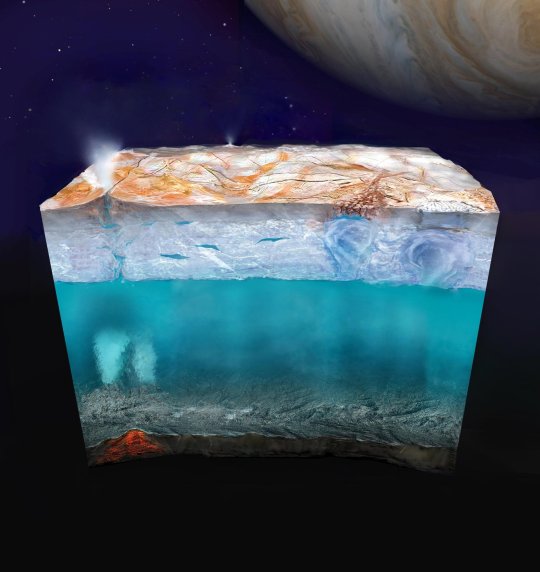

Can Life Exist on an Icy Moon? NASA’s Europa Clipper Aims to Find Out
With a spacecraft launching soon, the mission will try to answer the question of whether there are ingredients suitable for life in the ocean below Europa’s icy crust.
Deep down, in an ocean beneath its ice shell, Jupiter’s moon Europa might be temperate and nutrient-rich, an ideal environment for some form of life — what scientists would call “habitable.” NASA’s Europa Clipper mission aims to find out.
NASA now is targeting launch no earlier than Monday, Oct. 14, on a SpaceX Falcon Heavy rocket from Launch Complex 39A at NASA’s Kennedy Space Center in Florida.
Europa Clipper’s elongated, looping orbit around Jupiter will minimize the spacecraft’s exposure to intense radiation while allowing it to dive in for close passes by Europa. Using a formidable array of instruments for each of the mission’s 49 flybys, scientists will be able to “see” how thick the moon’s icy shell is and gain a deeper understanding of the vast ocean beneath. They’ll inventory material on the surface that might have come up from below, search for the fingerprints of organic compounds that form life’s building blocks, and sample any gases ejected from the moon for evidence of habitability.
Mission scientists will analyze the results, probing beneath the moon’s frozen shell for signs of a water world capable of supporting life.
“It’s important to us to paint a picture of what that alien ocean is like — the kind of chemistry or even biochemistry that could be happening there,” said Morgan Cable, an astrobiologist and member of the Europa Clipper science team at NASA’s Jet Propulsion Laboratory in Southern California, which manages the mission.
Ice Investigation
Central to that work is hunting for the types of salts, ices, and organic material that make up the key ingredients of a habitable world. That’s where an imager called MISE (Mapping Imaging Spectrometer for Europa) comes in. Operating in the infrared, the spacecraft’s MISE divides reflected light into various wavelengths to identify the corresponding atoms and molecules.
The mission will also try to locate potential hot spots near Europa’s surface, where plumes could bring deep ocean material closer to the surface, using an instrument called E-THEMIS (Europa Thermal Emission Imaging System), which also operates in the infrared.
Capturing sharply detailed pictures of Europa’s surface with both a narrow and a wide-image camera is the task of the EIS (Europa Imaging System). “The EIS imagers will give us incredibly high-resolution images to understand how Europa’s surface evolved and is continuing to change,” Cable said.
Gases and Grains
NASA’s Cassini mission spotted a giant plume of water vapor erupting from multiple jets near the south pole of Saturn’s ice-covered moon Enceladus. Europa may also emit misty plumes of water, pulled from its ocean or reservoirs in its shell. Europa Clipper’s instrument called Europa-UVS (Europa Ultraviolet Spectrograph) will search for plumes and can study any material that might be venting into space.
Whether or not Europa has plumes, the spacecraft carries two instruments to analyze the small amount of gas and dust particles ejected from the moon’s surface by impacts with micrometeorites and high-energy particles: MASPEX (MAss SPectrometer for Planetary EXploration/Europa) and SUDA (SUrface Dust Analyzer) will capture the tiny pieces of material ejected from the surface, turning them into charged particles to reveal their composition.
“The spacecraft will study gas and grains coming off Europa by sticking out its tongue and tasting those grains, breathing in those gases,” said Cable.
Inside and Out
The mission will look at Europa’s external and internal structure in various ways, too, because both have far-reaching implications for the moon’s habitability.
To gain insights into the ice shell’s thickness and the ocean’s existence, along with its depth and salinity, the mission will measure the moon’s induced magnetic field with the ECM (Europa Clipper Magnetometer) and combine that data with measurements of electrical currents from charged particles flowing around Europa — data provided by PIMS (Plasma Instrument for Magnetic Sounding).
In addition, scientists will look for details on everything from the presence of the ocean to the structure and topography of the ice using REASON (Radar for Europa Assessment and Sounding to Near-surface), which will peer up to 18 miles (29 kilometers) into the shell — itself a potentially habitable environment. Measuring the changes that Europa’s gravity causes in radio signals should help nail down ice thickness and ocean depth.
“Non-icy materials on the surface could get moved into deep interior pockets of briny water within the icy shell,” said Steve Vance, an astrobiologist and geophysicist who also is a member of the Europa Clipper science team at JPL. “Some might be large enough to be considered lakes, or at least ponds.”
Using the data gathered to inform extensive computer modeling of Europa’s interior structure also could reveal the ocean’s composition and allow estimates of its temperature profile, Vance said.
Whatever conditions are discovered, the findings will open a new chapter in the search for life beyond Earth. “It’s almost certain Europa Clipper will raise as many questions or more than it answers — a whole different class than the ones we’ve been thinking of for the last 25 years,” Vance said.
TOP IMAGE: This artist’s concept (not to scale) depicts what Europa’s internal structure could look like: an outer shell of ice, perhaps with plumes of material venting from beneath the surface; a deep, global layer of liquid water; and a rocky interior, potentially with hydrothermal vents on the seafloor. Credit: NASA/JPL-Caltech
LOWER IMAGE: The puzzling surface of Jupiter’s icy moon Europa looms large in this reprocessed color view made from images taken by NASA’s Galileo spacecraft in the late 1990s. The images were assembled into a realistic color view of the surface that approximates how Europa would appear to the human eye. Credit: NASA/JPL-Caltech/SETI Institute
41 notes
·
View notes
Text
Quirks and features of the James Webb Space Telescope

The James Webb Space Telescope (JWST) is a ten billion dollar space telescope that weighs 14,000 pounds, is the size of a bus, and took decades to construct. It's been in the news recently, you might have heard about it.
The development, launch and deployment of the JWST were fraught with unexpected setbacks, terror and frights, 344 "single-point failures", any one of which that, if they failed during deployment, could doom the entire spacecraft to uselessness, since it orbits far out beyond where any current manned spacecraft could even attempt a repair job.
The fact that it came online as smoothly as it did was something of a surprise to the people in charge. Given the miracle of it making it to space at all, the press coverage of JWST has focused on the positives. But a stroll through the JWST user documentation by a curious reader reveals much that is interesting, or interestingly broken. Such as..
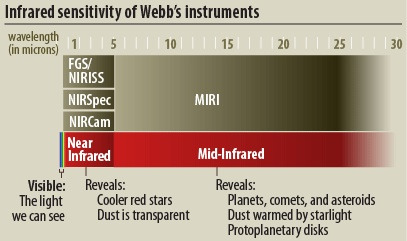
Fun and games with infrared
Specifically, the JWST is an infrared telescope, designed to collect light that's redder than red. The two dedicated imaging instruments are the Near Infrared Camera (NIRCam) collecting light from 0.6 micrometers to 5.0 micrometers and the Mid-Infrared Instrument (MIRI) collecting light from 5.6 micrometers to 25.5 micrometers. (Though with significant light collected past 25.5 um by filter F2550W)
The wonderful thing about infrared astronomy is that everything emits blackbody radiation, and the hotter it is the more infrared it emits. The unfortunate thing about infrared astronomy is that everything emits blackbody radiation, including your telescope, and self-emission from your telescope can swamp the faint signal from astronomical sources. (Like building a camera out of glowsticks.)
The equilibrium temperature for an object in Earth orbit is about 300 Kelvin. (26C) Everything on the other side of the sunshield passively cools down to 40K, and MIRI is actively cooled by the cryocooler down to a chilly 6K (-267C, -449F) This extends MIRI's seeing range deeper into infrared.
But the mirror is still warm! At the far end, MIRI is significantly compromised by thermal self-emission: (Note log scale!)
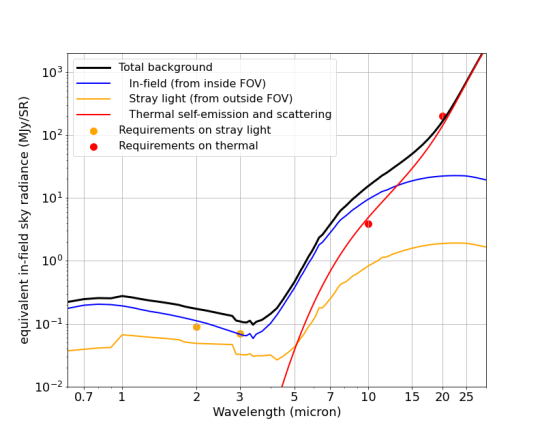
This is more graphically illustrated by one of the MIRI commissioning images:

Check out that background glare!
(This is somewhat unfair: the calibration target here is a star, which emits comparatively little light in far-infrared. MIRI is really meant for nebulae and extra-galactic high-redshift objects)
("Why not actively cool the mirror?" Mechanical cryocoolers operate on the very limit of what heat engines are capable of. The MIRI cryocooler draws a fat 180 watts to move 78 milliwatts of heat. Previous infrared telescopes used a fixed amount of expendable coolant (liquid helium or solid hydrogen) to cool the entire instrument package... at the cost of a much smaller primary mirror and a telescope that flat out just stopped working when it ran out of coolant.)
There's something else you might notice about the above series of photographs...
Thanks a lot, Lord Rayleigh
John William Strutt, 3rd Baron Rayleigh was a typical early physicist in that he has a great big pile of "discoveries" by virtue of being the first person to 1) notice something and 2) actually write it down. One of them is the fundamental theorem for the angular resolution of an optical system, the Rayleigh criterion. It is dead simple:

Resolution is roughly equal to 1.22 times the wavelength of the light you're looking at, divided by the diameter of the aperture. Bigger the opening at the front of light bucket, the higher the resolution. Smaller the wavelength of light, the higher the resolution.
(Fun fact: the former Arecibo radio observatory, once the largest single telescope in the world with a 305 meter wide dish, had about the same angular resolution in radio waves as the human eye does in visible light.)
You can imagine the effect this has on an infrared telescope. And sure enough, in the user documentation for the two imaging sensors, it states a pixel scale of 0.031 arcseconds for 0.6 to 2.3 micrometers light wavelength, 0.063 arcsec/px for 2.4-5.0 µm, and a squishy 0.11 arcsec/px for 5.6-25.5 µm.
But this is just how many pixels are on the detector. The resolution gets much worse at long wavelengths, as you can see in the commissioning image, where the extra pixels oversample a progressively vaguer blob. The Rayleigh criterion holds that the 6.5 meter wide JWST primary mirror should manage 0.206 arcsec at 5.32 µm, falling to 0.42 arcsec at 10.85 µm, 0.747 arcsec at 19.29 µm, and an unfortunate 1.014 arcsec at 26.2 µm. One wonders why the designers went to heroic lengths to cool MIRI down to 7 kelvin, instead of using that cryocooler mass and power budget for more detector surface area.
Knowing this, you can spot how the JWST's press team works around the limitations of the telescope. Like how a "look at how good our infrared telescope" commissioning photo happens to use the 7.7 µm mode:

Or how if you browse the photos on the webbtelescope.org site, you will see lots of NIRcam output in the "oooh, ah, new desktop background" category, but not so much MIRI.
(Another amusing detail of MIRI is that bright objects leave afterimages ("latents") on the sensor, so once a week they warm the sensor up to a tropical 20 kelvin before cooling it down again, a "MIRI anneal". You can see when anneals are performed, as well as what the telescope is looking at right now, by viewing the public schedule.)
But this is Webb operating right up to its full specifications. How about something that's actually broken?
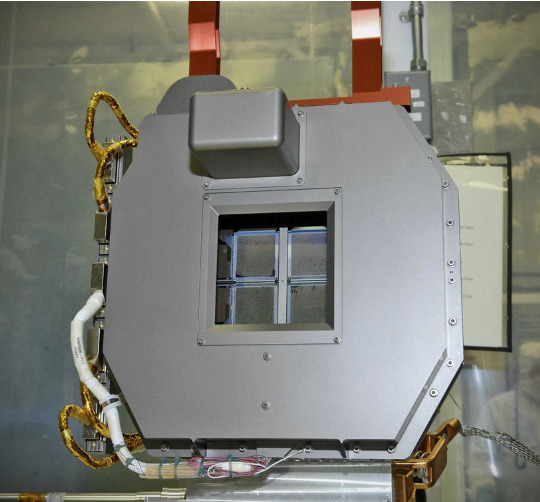
NIRSpec my beloved
The Near-Infrared Spectrograph (NIRSpec) instrument takes incoming light and runs it through a diffraction grating to produce a spectrum. When scientists say that the Sun is 0.77% oxygen, 0.29% carbon, etc, it's not because someone flew a spacecraft over to it and collected a bucket of solar plasma, it's because you can look at the absorption lines in the spectra to figure out its composition.
Spectrometry is also used to measure redshift, a close proxy to distance. When a press release says that a galaxy is "ten million lightyears away", it's not because NASA has a really long tape measure they haven't told anyone about, it's because a spectrometer measured how much cosmological redshift has moved a spectrum line. Naturally, it's not quite as easy as pointing a sensor at a object and getting back a single, unambiguous result. Distant objects are also dim objects, so the spectra will be noisy and chewed up by dust and other contamination its endured in the millions of years its traveled to arrive at our telescopes. Bleeding edge astronomy is thus the practice of designing statistical models to fit to noisy, fragmented data, and then arguing with other astronomers about r^2.
In any event, it's a handy thing to have on a telescope. Naturally, JWST has more than one. In fact every instrument has a spectroscopy mode. Besides the dedicated NIRISS and NIRSpec instruments, both NIRcam and MIRI include diffraction gratings in their filter wheels that smear out incoming light, like looking through a prism:
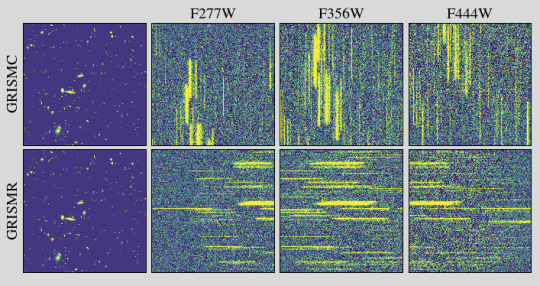
Pointing the JWST at an object is relatively expensive, since it requires rotating ("slewing") the entire darn spacecraft, and an amusingly complex alignment procedure with the fine guidance sensor and fine steering mirror. Considering how long it would take to shoot a hundred spectra with a conventional fixed slit rigidly mounted to the telescope frame, you can see the appeal of gathering a hundred spectra in a single exposure with "slitless" spectroscopy.
(Longtime space telescope nerds might hear the word "slewing" and involuntarily twitch, recalling that the reaction wheels and gyroscopes were a problem point on the Hubble, requiring several servicing missions, and also significantly affecting operations on the Kepler space telescope. Fortunately, JWST switched to a gyroscope type that has no moving parts, and used some mass budget to install six reaction wheels, up from Hubble's four, giving it three spares.)
You can also see the big downside in the image above, which is there's a hard tradeoff between how long a spectrum can be (and thus its resolution!) before it'll overlap its neighbors and be useless. Most of the slitless modes therefore have two gratings at two different angles, (GRISMR and GRISMC above) but wouldn't it great if you could just block out all that other light?

Thus, the Micro Shutter Array, as seen above. The best of both worlds! Capture many spectra at the same time, while blocking off light you don't want from contaminating the field, using a configurable array of nearly a quarter million microscopic, individually actuated moving shutters.
Lots and lots and lots of tiny little moving parts, installed in the guts of a spacecraft that's orbiting out past the Moon, impossible to access or replace.
Yeah, a bunch of them broke:

When it was handed over to NASA for installation into Webb in 2007, the MSA already had 150 shutters that no longer responded to opening commands in just one of the four submodules.
By the time JWST emerged from commissioning and was declared fully operational in 2022, 15,893 shutters, 7% of the total, had "failed closed." Hilariously, 904 of those failed during post-launch testing, and the authors of that paper note that, on average, if you tell 100 shutters to close, 4 of them will jam shut and no longer work.
This is unfortunate, but fairly easy to work around. What's worse are the shutters that are stuck open:
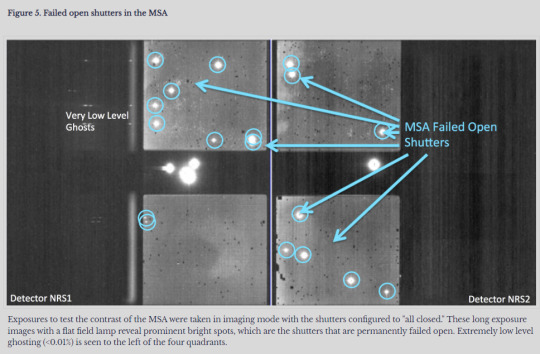
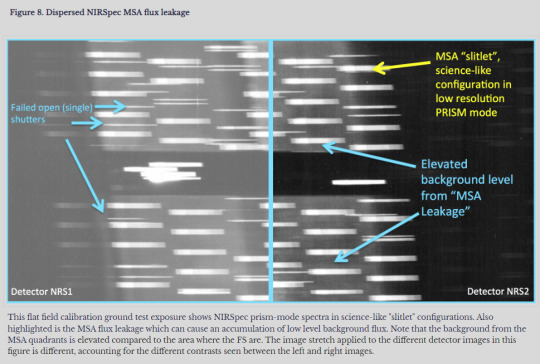
These permanently open shutters then compromise big chunks of the sensor. Commissioning testing jammed two more of them open, taking the total up to 22. You can imagine that if a few dozen more of these fail-open during routine operation then the entire microshutter array observation mode won't be much more useful than regular slitless spectrography.
And this, right here, sums up the essentially "interim" nature of JWST. After all, it was only supposed to cost $500 million and take a mere nine years from design to launch. All becomes clear in that light. Why give it a shutter array that falls apart in use? Why have the mirror exposed to space, where it gets hit with micrometeoroids? Why only design it to carry ten years worth of fuel? Because it was supposed to be half the price of Hubble!
The 90s was the era of "faster, better, cheaper". JWST was going to be an incremental improvement on a long series of previous infrared telescopes, and a stepping stone to the next one. It wasn't supposed to be an eternal monument to Science, and a financial black hole consuming NASA's entire budget.
So what went wrong?
We shouldn't have built one JWST.
Those 344 single points of failure. Any single one of them can end the mission. There's just one telescope, no backups, no trying again. Bureaucrats are harshly punished for failure, lightly rewarded for success. It's always easier to wait, do more tests, delay the schedule a bit more at a hint of trouble. Engineers can get you to 90% reliable no problem, but getting to 99% reliable takes another decade and nine billion more dollars.
Our techne is just bad at producing flawless machines first try. For the price of one reliable JWST we could have put twenty into orbit... but the first five would have been embarrassing failures. Spars sticking in place, sunshields jamming, thrusters misfiring. To save the shame of $0.5 billion wasted, NASA happily spent $9.5 billion. Why not? Because money spent is invisible, but failure is painfully apparent.
A critical third party can draw unflattering parallels. The crowning achievement of NASA, the Moon Landing... required eleven Apollo launches and twenty Surveyor launches before a single man set foot on lunar regolith! Quite a few of those spacecraft pancaked into the Moon and exploded on the launchpad before we figured out this "space" thing. Three men died! But NASA was on a hard deadline, with a fixed budget, and the only way to get a home run is to take a lot of swings at the ball.
Another comparison is the Space Launch System, NASA's attempt to make the Saturn V again. So far $27 billion has been lit on fire to put exactly one test load into orbit, with the primary contractor now desperate to get out of its contact. Slow, careful, incremental development has completely failed to produce a working launch system.
Meanwhile, SpaceX produced a series of public, embarrassing failures... resulting in the world's only reusable launch system, and as a result has put far more mass into orbit than any country in the world.
The only way to develop a flight system is flight tests.
Space telescope deploy mechanisms meant to work in zero gravity can't be tested on the ground.
They can only be tested in space.
NASA administrators who didn't work during Apollo are too stupid to understand this. Fire them all!
These geriatrics have happily sacrificed science in order to play it safe and secure their own easy retirement. Do we want 15 risky JWST telescopes by 2010, or do we want one reliable one by 2022? The answer is obvious!

For the money we wasted making Webb more reliable, we could have launched a space telescope far outside the disk of dust in the inner solar system, allowing it to see deeper into space than Webb ever could. ESA put an astrometry space telescope just outside Earth orbit, measuring angles between stellar objects, which is the only way to directly measure the distance to the stars. Great first step. The obvious next step is to send more of these telescopes out past Neptune's orbit, to capture better observations with a vastly larger baseline, something that can never be done by an Earthly observatory. Are there any plans to do this? No!
Space exploration is paralyzed by boomers, mired in the mental tarpit of the 1970s, where each gram to orbit is terribly expensive and must be counted on punched cards and summed with slide rules. Meanwhile, SpaceX Starship is on its way to orbit, and each one can carry sixteen JWSTs with room to spare!
The old paradigm is done. Telescopes don't need folding mirrors and exotic materials, they need to be mass produced. There is no excuse not to have a hundred more JWST-class telescopes lined up next to the Texas launch pad waiting for Starship to come online. But as far as I know not a single space mission even mentions it-- that's how afraid they are of risk!
The JWST, with its myriad of fragile components and its staggering price tag, stands as a monument not to our ingenuity but to our inability to let go of outdated ideals.
We must abandon the notion that space is a realm reserved for the flawless and the infallible. Instead, we should embrace the chaos, the unpredictability, the sheer messiness of exploration. Let us launch a thousand telescopes, each a patchwork of parts, each destined to fail in its own spectacular way. For it is only in this embrace of the ephemeral that we can find out what actually works!
Let the JWST be the last of its kind, a relic of a bygone era. The future is unwritten, and it is ours to fill with a symphony of failures, each note a step closer to the stars.
278 notes
·
View notes
Text
I Saw Sam Altman's Iris-Scanning "Orb" In Brazil — And We Should All Be Scared As Hell
The initiative led by Open AI CEO Sam Altman to create a global identity system through iris scanning has landed in Brazil. But what about privacy, transparency and the ethical implications of such a vast biometric project?
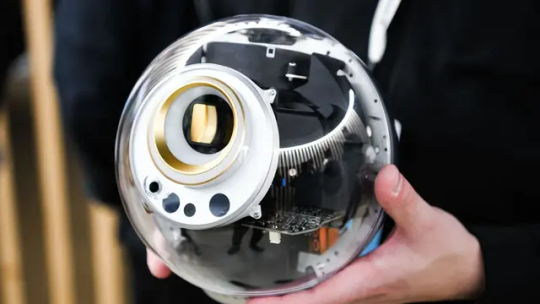
I arrived late at the elegant house in the Vila Nova Conceição neighborhood of São Paulo, Brazil; the event was about to start. A handful of journalists were already gathered around a table with coffee, tea, cookies and snacks at the back of the house. But the tension was palpable; those tasked with "selling" the product to the press knew that they were facing a significant challenge.
When questions poured in — accompanied by few answers — it became increasingly clear that the Brazilian launch of World was prompting far more questions than applause.
Starting Nov. 13, World — an initiative created by OpenAI CEO Sam Altman — began scanning the eyes of Brazilians to add to a database that, according to the company, already contains biometric data from more than 7 million individuals. They started with 10 locations in the city of São Paulo — in shopping malls and with street stands.
I'll spare you the adjectives, because the story speaks for itself. Readers are welcome to use some of the concepts I usually use around in my column (techno-oligarchy, neocolonialism, techno-feudalism, etc.).
This is how World is currently promoting its work and purpose: it wants to create a global identity that ensures that the person using it is a human being.
The idea, conceived by founders Sam Altman, Alex Blania and Max Novendstern and financed from the outset by investor Andreessen Horowitz, responds to the growing difficulty computers face in verifying whether a user is a person or a robot. Essentially, with the evolution of AI, those captcha tests are becoming increasingly obsolete.
World created a machine called Orb — a black sphere designed to resemble something out of a science fiction movie — to scan each person's iris to provide them with a unique identity. According to an extensive report from BuzzFeed News, Orb uses a thermal scanner to check people's body temperature, a 3D camera to map faces, and high-resolution cameras to capture videos and images of bodies, faces and irises — all to prove that it is indeed a real person and not just a photo.
The biometric data is reportedly not stored by the organization; only encoded values known as hashes are kept across various servers at universities so that “the iris cannot be reconstructed.” We have to trust that this is true because, as with other tech companies, there is no oversight body that can verify if this promise is indeed fulfilled.
But the issue lies not only in the lack of transparency regarding how data is stored and destroyed or with whom the company shares it — with BuzzFeed's report indicating that World’s data-sharing contract allowed it to share user data with third parties as it saw fit.
The problem begins with the narrative that the organization wants to sell.
Continue reading.
#brazil#brazilian politics#politics#artificial intelligence#data rights#image description in alt#mod nise da silveira
10 notes
·
View notes
Text
The different Mars Rovers and what we learned
Sojourner (1997)
First rover to successfully land on Mars. Defined by NASA as a "micro-rover" due to its small size, Sojourner had a speed of maximum of 0.4 meters pr. minute. It was active for about 80 days on the surface of Mars.
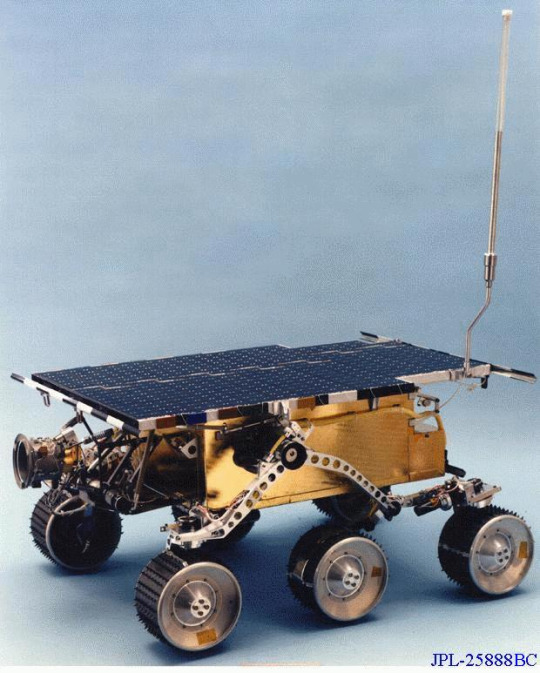
Sojourner carried three cameras, an Atmospheric Structure Instrument (Meteorology Package) and an Alpha Proton X-ray Spectrometer. There instruments.
From Sojourner, NASA learned about the surface and weather conditions of Mars.
Sojourner found rounded rocks at the landing site, which suggests that running water could have been on Mars. The radio-tracking of Pathfinder (mission name) also gave an estimate of Mars' metal core's size (1300 kilometers to 2000 kilometers). It also discovered that the dust that is in the air on Mars is magnetic and possibly made up of mahemite. Sojourner also observed dust devils, ice clouds in the lower atmosphere and temperature fluctuations on the surface of Mars.
Spirit (2004-2010) and Opportunity (2004-2018)
Spirit was one of two Mars rovers launched in 2003 (mission started in 2004). The wheels on Spirit and Opportunity were about double the size of Sojourners. The weight of both rovers was about 17 times Sojourners, and more than double the size. Their goal on Mars was to search the surface for traces of past water. In 2009, Spirit got stuck in soil (in the area called Troy). In 2010, Spirit stopped communications, and the mission ended in 2011.
Opportunity was launched in 2004 along with Spirit but lasted much longer than their twin. Setting the record for the longest-lasting Mars rover, Opportunity stopped communications in 2018. Opportunity also set the record for the longest distance traveled by a rover, around 45 kilometers.
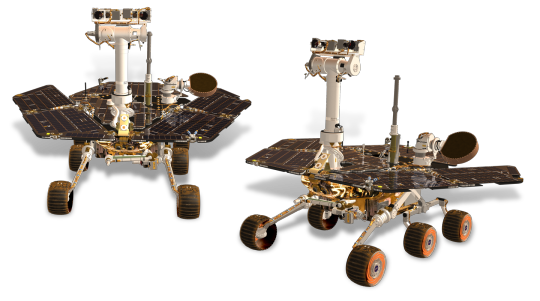
Like Sojourner, Spirit provided data about Mars' weather conditions, especially the wind. Both Spirit and Opportunity found evidence of possible conditions on Mars that could allow microbial life.
Spirit and Opportunity both had panoramic cameras, a thermal emission spectrometer, a Moessbauer spectrometer, an alpha particle X-ray spectrometer, and a microscopic imager.
Curiosity (2012-present)
Curiosity is currently the oldest active Mars rover (as of 21/07/2023) The main purpose of Curiosity is to figure out if Mars has the right environment for microbial lifeforms. Curiosity is currently exploring Gale Crater and had the most advanced instruments at the time. Curiosity has found evidence of water having been on Mars in the past, found old organic material, and discovered that Mars has had a thicker atmosphere in the past.
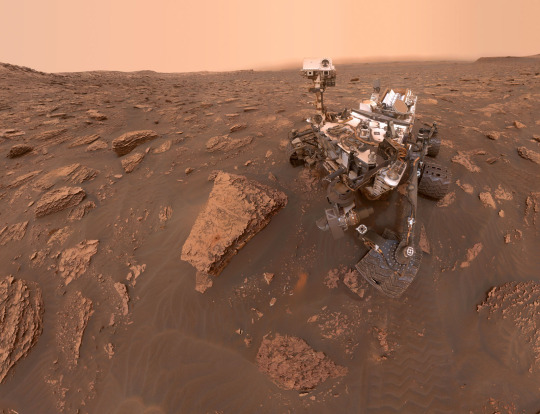
Curiosity can climb over knee-high obstacles and can go up to 30 meters per hour.
Curiosity carries a radioisotope power system to generate electricity, which gives the rover a steady electricity flow. Curiosity also carries 17 cameras, a laser, a drill, and 10 different instruments.
Perseverance (2021-present)
Perseverance is the newest Mars rover from NASA. The main goal for Perseverance is to research habitable conditions on Mars, but also for signs of past microbial life. The mission also tests possible options for future human expeditions on Mars (ex. improved landing techniques, producing oxygen from the atmosphere and environmental conditions).
The drill Perseverance used can collect samples and then set them aside for collection on the surface.
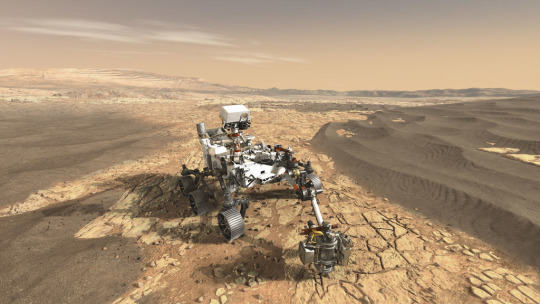
Zhurong (2021-2022)
Launched by the CNSA, Zhurong is the first Chinese Mars rover. In 2022 it became inactive due to sandstorms and the winter, which prevented it from waking at an appropriate temperature and good sunlight conditions.
Zhurong's mission was to study the topography, examine the surface (soil and elements), and take samples of the atmosphere. To do this it had a RoPeR (Mars Rover Penetrating Radar), RoMAG (Mars Rover Magnetometer), MCS (Mars Climate Station), MarSCoDE (Mars Surface Compound Detector), a multispectral camera and navigation and topography cameras. It also had a remote camera on board.

#astronomy#mars rover#sojourner#spirit#opportunity#curiosity#perseverance#zhurong#nasa#source: mars.nasa.gov#source:wikipedia#mainly for zhurong
54 notes
·
View notes
Text

"SILTS camera infrared image of the flight surfaces of Columbia during STS-28 reentry."

"The Shuttle Infrared Lee-side Temperature Sensing (SILTS) camera package made its second flight aboard Columbia on this mission. The cylindrical pod and surrounding black tiles on the orbiter's vertical stabilizer housed an imaging system, designed to map thermodynamic conditions during reentry, on the surfaces visible from the top of the tail fin. Ironically, the camera faced the port wing of Columbia, which was breached by superheated plasma on its disastrous final flight, destroying the wing and, later, the orbiter. The SILTS system was used for only six missions before being deactivated, but the pod remained for the duration of Columbia's career. Columbia's thermal protection system was also upgraded to a similar configuration as Discovery and Atlantis in between the loss of Challenger and STS-28, with many of the white LRSI tiles replaced with felt insulation blankets in order to reduce weight and turnaround time. One other minor modification that debuted on STS-28 was the move of Columbia's name from its payload bay doors to the fuselage, allowing the orbiter to be easily recognized while in orbit."
Information from Wikipedia: link

Date: August 13, 1989
source, source, source
#STS-28#Space Shuttle#Space Shuttle Columbia#Columbia#OV-102#Orbiter#NASA#Space Shuttle Program#August#1989#Shuttle Lee-side Temperature Sensing#SILTS#re-entry#my post
26 notes
·
View notes
Text
online gadget review
The iPhone 16 series, launched in September 2024, brings notable upgrades across its standard and Pro models. Here's a summary of its key features:
Standard Models (iPhone 16 & iPhone 16 Plus):
Processor: Powered by the A18 chip, offering improved AI and graphics capabilities.
Cameras: A 48MP main camera supports 2x optical zoom via sensor cropping, and the 12MP ultrawide camera now enables macro photography.
Display: Bright and efficient OLED panels.
Battery: Promises better performance, though Apple has not disclosed the exact capacity.
Charging: Enhanced wireless MagSafe charging (up to 25W) and wired charging (up to 45W).
Pro Models (iPhone 16 Pro & Pro Max):
Processor: Equipped with the A18 Pro chip, which features faster CPU, GPU, and neural processing capabilities.
Cameras: A triple-camera system with a 48MP Fusion main camera, an enhanced ultrawide lens, and a 5x telephoto camera on both Pro models. New features include 4K120fps video recording and spatial video for immersive content on Apple Vision Pro.
Audio and Video: Advanced editing tools like Audio Mix, spatial audio capture, and wind noise reduction for professional-grade content creation.
Design: Improved thermal performance with a graphite layer in Pro models for demanding tasks like gaming.
Software & AI:
Both standard and Pro models benefit from iOS 18, introducing features like customizable home screens, advanced AI tools (e.g., ChatGPT-powered Siri), and privacy improvements. Apple Intelligence tools also support text summarization, email proofreading, and generative image creation.
Pricing:
2 notes
·
View notes
Note
What're your top 4 favourite games of all time?
I actually pretty recently went through my Top 25 on Twitter but that's mostly a contextless image with no words to it, so I do wanna spend a little more time to highlight my four favorite games (1024 words):
4. Earthbound (SNES, 1995)

Earthbound is a truly superb JRPG, with a kitsch and a camp to it that feels simultaneously cheesily-dated and timeless to boot, with a charisma and world that's ripe for exploration, from a guy who is a master craftsman of compelling stories. This is by far my favorite game to actually play in the SNES' library.
3. Hypnospace Outlaw (PC/XBO/PS4/Switch, 2019)

Back-to-back 90s-flavored games with phenomenal storytelling, Hypnospace Outlaw is a game about playing the moderator of an alternate timeline's niche corner of the Internet. Users on Hypnospace create webpages with their mind so they can hang out and be productive while asleep, and the characters are deeply nuanced with tons of personal details and secrets in tow. It's fun to be an enforcer and track down cases, but it's just as fun to go down the rabbit hole and follow links, and your curious nature is handily rewarded with shortcuts, hacks to be a better enforcer, fun Angelfire/Geocities webpages with MIDIs or ripped MP3s for backing music, and an utterly stellar story of corporate mismanagement, cover-ups, and an attempt to pin this universe's Y2k bug on an innocent kid that makes up the game's final act, a retrospective as you work to archive Hypnospace for modern audiences and tie up any loose ends. Jay Tholen's world is eclectic, surreal, and so oppressively 90s that you *will* listen to their fake Linkin Park on its own long after you play this.
2. Hot Dogs, Horseshoes, & Hand Grenades (PCVR, 2016-)

Rust LTD's range simulator/physics sandbox stands out as one of the defining games in PCVR spaces. Being the brainchild of developer Anton Hand and having been in incredibly active development for eight years, H3VR's dedication to the craft of firearm simulation is matched with a quirky, lighthearted sense of humor that extends into the enemies; sosigs bleed mustard* and say cheesy one-liners or compliment the player before exploding into meat, and Anton's strict adherence to not including real-world human enemies or gore extends to the lore explanation of the seemingly endless number of enemies being a giant meat grinder and casing stuffer that brings units to life. This has pissed off *tons* of fans of other VR FPSes, but I've been long enamored with Anton's realization that what people want from gore (satisfying particles and deformation, cathartic violence) can be done super cheaply and in an approachable manner for all-ages while still maintaining a very strong network of AI pathing and handling systems.
Even if you aren't fighting the enemies, the game's core simulations are still fun to engage with, with lovingly rendered guns that let you see their specific oddities, effectively digitally preserving over 500 firearms, both real and fictional (including a handful of pop cultural pieces like the guns from Robocop, Blade Runner, and Team Fortress 2 in an official collab with Valve) and their inner workings while giving you an expansive sandbox for building scenarios, be they IPSC-style accuracy trials or a simple bed of targets to plink at. Anton still updates this game weekly, working on things like night vision goggles/scopes, thermal cameras, and a Hitman-inspired ImSim mode. Despite this, Anton still does not see the game as a 1.0 finished build, and has plans to continue updating the game for a long while to come.
Cruelty Squad (PC, 2021)

There is no other game like Cruelty Squad, man. Its roots lie in underground artist Ville Kallio, a Finnish creator of the strange, surreal, and visceral. So much of Kallio's art centered around video games and they way they depict and discuss violence, and he took his work to its logical conclusion with an Immersive Sim unlike any other. The visuals are garish, the music is shoddy, the maps are nonsensical with a bizarre fetishization of ad-soaked dystopia, and does a great job of putting you into the headspace of the depressed former Death Squad member Empty Fuck, who finds himself becoming a gig economy worker settling petty corporate disputes for his former boss with the aid of a slew of lethal, stupid weaponry.
For your trouble, you're paid out a pittance, so most of your income has to come from side hustles. Gibbing enemies lets you harvest their organs, which is fantastic for you as modern medicine has made death a thing of the past, stitching cadavers back to life and saddling them with medical debt. If you're not fishing or playing the incredibly volatile stock market that experiences a short squeeze that reaches MOASS levels, you're organ harvesting, which also nets you an opportunity to steal a fallen foe's weapons after you scoop up his liver and kidneys, as you can only get new guns by carrying them out with you on a successful hit. The game takes you to cultist lairs, cushy offices with armed guards, a bombed out nightclub in Helsinki created in the aftermath of a chemical weapons attack to blockbust the district, and straight up to Cruelty Squad HQ to confront the balance of life and death in the world.

Cruelty Squad is truly so beautiful in its unabashed ugliness. The NPCs complain about their life and financial woes while their bosses gamble the extracted value of their labor on buying new yachts, advertisements for the game's brands are everywhere, and though the wealthy bourgeois are free to flaunt their wealth and perversion, the common prole finds themselves in a constant loop of being caught in the crossfire of mass shootings and waking up an instant later with discharge paperwork and a hospital bill. Kallio has made a truly chaotic, bitter, visceral world mirroring our own frustrations with the modern technology and finance sectors, and displays an incredible understanding of game design through all of the design decisions clearly meant to draw the most ire and frustration. It's not an easy game to enjoy, Cruelty Squad. It's difficult with an unfair difficulty curve and some decently bad levels, but my GOD its marriage of Deus Ex and Hitman ImSim sensibilities and a passionate disdain for late-stage Capitalism make it an easy choice for my favorite game of all time.
3 notes
·
View notes
Text
Essential Steps in Water Damage Restoration
Water damage can wreak havoc on your property, leading to costly repairs and potential health hazards. Whether caused by natural disasters, plumbing failures, or human error, the impact of water damage can be extensive and devastating. Effective water damage restoration is crucial to mitigate these impacts and restore your property to its former state. Here are the essential steps involved in water damage restoration.
Assessment
The first step in water damage restoration is a thorough assessment of the affected area. Identifying the extent of water damage is critical to determine the necessary course of action. Quick assessment is vital as prolonged water exposure can lead to structural damage and mold growth. Professional restoration companies use advanced tools like moisture meters and thermal imaging cameras to detect hidden water damage.
Water Extraction
Once the assessment is complete, the next step is water extraction. Removing standing water as quickly as possible minimizes further damage to the property. Various methods and equipment are used for water extraction, including submersible pumps, wet vacuums, and industrial-strength water extractors. While DIY methods may be effective for minor leaks, professional extraction is recommended for significant water damage to ensure thorough removal.
Drying and Dehumidification
After water extraction, the affected areas must be dried and dehumidified to prevent mold and mildew growth. Techniques for effective drying include the use of high-speed air movers and industrial-grade dehumidifiers. These devices accelerate the evaporation process and remove moisture from the air. Monitoring humidity levels and adjusting equipment as needed ensures that the drying process is efficient and complete.

Restoration and Repair
Restoration and repair are essential to return your property to its pre-damage condition. This step involves repairing structural damage, such as replacing drywall, flooring, and insulation. Addressing mold and mildew is also crucial, as these can pose serious health risks. Professional restoration services use antimicrobial treatments and specialized cleaning techniques to eliminate mold spores and prevent future growth.
Prevention
Preventing future water damage is the final step in the restoration process. Regular maintenance and timely repairs can significantly reduce the risk of water damage. Here are some preventive tips:
Inspect and maintain your plumbing system regularly.
Ensure proper drainage around your property.
Install a sump pump in your basement.
Use water leak detectors and alarms.
Keep gutters and downspouts clean and functional.
Conclusion
Water damage restoration is a multi-step process that requires prompt action and professional expertise. By following these essential steps—assessment, water extraction, drying and dehumidification, restoration and repair, and prevention—you can effectively mitigate the impacts of water damage and protect your property. Taking preventive measures and being prepared can save you time, money, and stress in the long run.
2 notes
·
View notes
Text
James Webb Space Telescope Discovers Surprising Revelations about Ganymede and Io. Full article here

🔭 The James Webb Space Telescope (JWST) is on a roll, revealing jaw-dropping discoveries about Jupiter's fascinating moons, Ganymede and Io! 🔭
🌌 Ganymede - The Largest Moon's Hidden Secret 🌌 JWST's sensitive infrared cameras exposed hydrogen peroxide (H2O2) around Ganymede's poles, a first-time detection! 🌠 The moon's magnetic field directs charged particles from Jupiter's magnetosphere towards the poles, causing a captivating process called radiolysis, altering the polar caps' surface chemistry. 🌈 This exciting find sheds light on icy bodies' chemistry across the outer solar system, unlocking the secrets of neighboring moons like Europa and Callisto! 🪐
🌋 Io - Unraveling Sulfurous Volcanic Mysteries 🌋 Io's volcanic prowess comes to the fore with JWST's high-resolution spectrometer. The thermal infrared measurements captured intense eruptions at Kanehekili Fluctus and Loki Patera. 🌋🔥 Thanks to JWST's observations, scientists linked sulfur monoxide (SO) emissions to volcanic activity, deepening our knowledge of Io's extreme geology and atmosphere. 🌠🔍
🚀 Exciting Times for Astronomy! 🚀 JWST's Early Release Science program is unlocking the cosmos' hidden gems! 🌟 These discoveries highlight the importance of investing in advanced space telescopes to unravel the universe's mysteries. 🌌 Let's celebrate the triumphs of science and look forward to more groundbreaking revelations from the James Webb Space Telescope! 🎉
📷 Image Credit: Samantha Trumbo, Cornell [Ganymede], and Imke de Pater, UC Berkeley [Io]
Download James Webb Discovery app at www.jameswebbdiscovery.com

13 notes
·
View notes
Link
A new, higher-resolution infrared camera outfitted with a variety of lightweight filters could probe sunlight reflected off Earth’s upper atmosphere and surface, improve forest fire warnings, and reveal the molecular composition of other planets. The cameras use sensitive, high-resolution strained-layer superlattice sensors, initially developed at NASA’s Goddard Space Flight Center in Greenbelt, Maryland, using IRAD, Internal Research and Development funding. Their compact construction, low mass, and adaptability enable engineers like Tilak Hewagama to adapt them to the needs of a variety of sciences. Goddard engineer Murzy Jhabvala holds the heart of his Compact Thermal Imager camera technology – a high-resolution, high-spectral range infrared sensor suitable for small satellites and missions to other solar-system objects. “Attaching filters directly to the detector eliminates the substantial mass of traditional lens and filter systems,” Hewagama said. “This allows a low-mass instrument with a compact focal plane which can now be chilled for infrared detection using smaller, more efficient coolers. Smaller satellites and missions can benefit from their resolution and accuracy.” Engineer Murzy Jhabvala led the initial sensor development at NASA’s Goddard Space Flight Center in Greenbelt, Maryland, as well as leading today’s filter integration efforts. Jhabvala also led the Compact Thermal Imager experiment on the International Space Station that demonstrated how the new sensor technology could survive in space while proving a major success for Earth science. More than 15 million images captured in two infrared bands earned inventors, Jhabvala, and NASA Goddard colleagues Don Jennings and Compton Tucker an agency Invention of the Year award for 2021. The Compact Thermal Imager captured unusually severe fires in Australia from its perch on the International Space Station in 2019 and 2020. With its high resolution, detected the shape and location of fire fronts and how far they were from settled areas — information critically important to first responders. Credit: NASA Data from the test provided detailed information about wildfires, better understanding of the vertical structure of Earth’s clouds and atmosphere, and captured an updraft caused by wind lifting off Earth’s land features called a gravity wave. The groundbreaking infrared sensors use layers of repeating molecular structures to interact with individual photons, or units of light. The sensors resolve more wavelengths of infrared at a higher resolution: 260 feet (80 meters) per pixel from orbit compared to 1,000 to 3,000 feet (375 to 1,000 meters) possible with current thermal cameras. The success of these heat-measuring cameras has drawn investments from NASA’s Earth Science Technology Office (ESTO), Small Business Innovation and Research, and other programs to further customize their reach and applications. Jhabvala and NASA’s Advanced Land Imaging Thermal IR Sensor (ALTIRS) team are developing a six-band version for this year’s LiDAR, Hyperspectral, & Thermal Imager (G-LiHT) airborne project. This first-of-its-kind camera will measure surface heat and enable pollution monitoring and fire observations at high frame rates, he said. NASA Goddard Earth scientist Doug Morton leads an ESTO project developing a Compact Fire Imager for wildfire detection and prediction. “We’re not going to see fewer fires, so we’re trying to understand how fires release energy over their life cycle,” Morton said. “This will help us better understand the new nature of fires in an increasingly flammable world.” CFI will monitor both the hottest fires which release more greenhouse gases and cooler, smoldering coals and ashes which produce more carbon monoxide and airborne particles like smoke and ash. “Those are key ingredients when it comes to safety and understanding the greenhouse gases released by burning,” Morton said. After they test the fire imager on airborne campaigns, Morton’s team envisions outfitting a fleet of 10 small satellites to provide global information about fires with more images per day. Combined with next generation computer models, he said, “this information can help the forest service and other firefighting agencies prevent fires, improve safety for firefighters on the front lines, and protect the life and property of those living in the path of fires.” Probing Clouds on Earth and Beyond Outfitted with polarization filters, the sensor could measure how ice particles in Earth’s upper atmosphere clouds scatter and polarize light, NASA Goddard Earth scientist Dong Wu said. This applications would complement NASA’s PACE — Plankton, Aerosol, Cloud, ocean Ecosystem — mission, Wu said, which revealed its first light images earlier this month. Both measure the polarization of light wave’s orientation in relation to the direction of travel from different parts of the infrared spectrum. “The PACE polarimeters monitor visible and shortwave-infrared light,” he explained. “The mission will focus on aerosol and ocean color sciences from daytime observations. At mid- and long-infrared wavelengths, the new Infrared polarimeter would capture cloud and surface properties from both day and night observations.” In another effort, Hewagama is working Jhabvala and Jennings to incorporate linear variable filters which provide even greater detail within the infrared spectrum. The filters reveal atmospheric molecules’ rotation and vibration as well as Earth’s surface composition. That technology could also benefit missions to rocky planets, comets, and asteroids, planetary scientist Carrie Anderson said. She said they could identify ice and volatile compounds emitted in enormous plumes from Saturn’s moon Enceladus. “They are essentially geysers of ice,” she said, “which of course are cold, but emit light within the new infrared sensor’s detection limits. Looking at the plumes against the backdrop of the Sun would allow us to identify their composition and vertical distribution very clearly.” By Karl B. Hille NASA’s Goddard Space Flight Center, Greenbelt, Md. Share Details Last Updated May 22, 2024 Related TermsGoddard TechnologyGoddard Space Flight CenterTechnology Keep Exploring Discover More Topics From NASA Goddard Technology Innovations Goddard's Office of the Chief Technologist oversees the center's technology research and development efforts and provides updates on the latest… Goddard’s Internal Research & Development Program (IRAD) Information and links for Goddard's IRAD and CIF technology research and development programs and other NASA tech development sources. Technology Goddard Office of the Chief Technologist Staff page for the Goddard Office of the Chief Technologist with portraits and short bios
2 notes
·
View notes